Factors Leading to Malaysia Airlines Underperformance
VerifiedAdded on 2023/01/18
|23
|4751
|83
AI Summary
This research design proposal focuses on studying the factors leading to Malaysia Airlines underperformance. It explores the concept of underperformance, analyzes the challenges faced by the airline, and provides suitable recommendations for improvement. The research methodology includes the use of positivism philosophy, survey research strategy, descriptive research design, and simple random probability sampling technique.
Contribute Materials
Your contribution can guide someone’s learning journey. Share your
documents today.
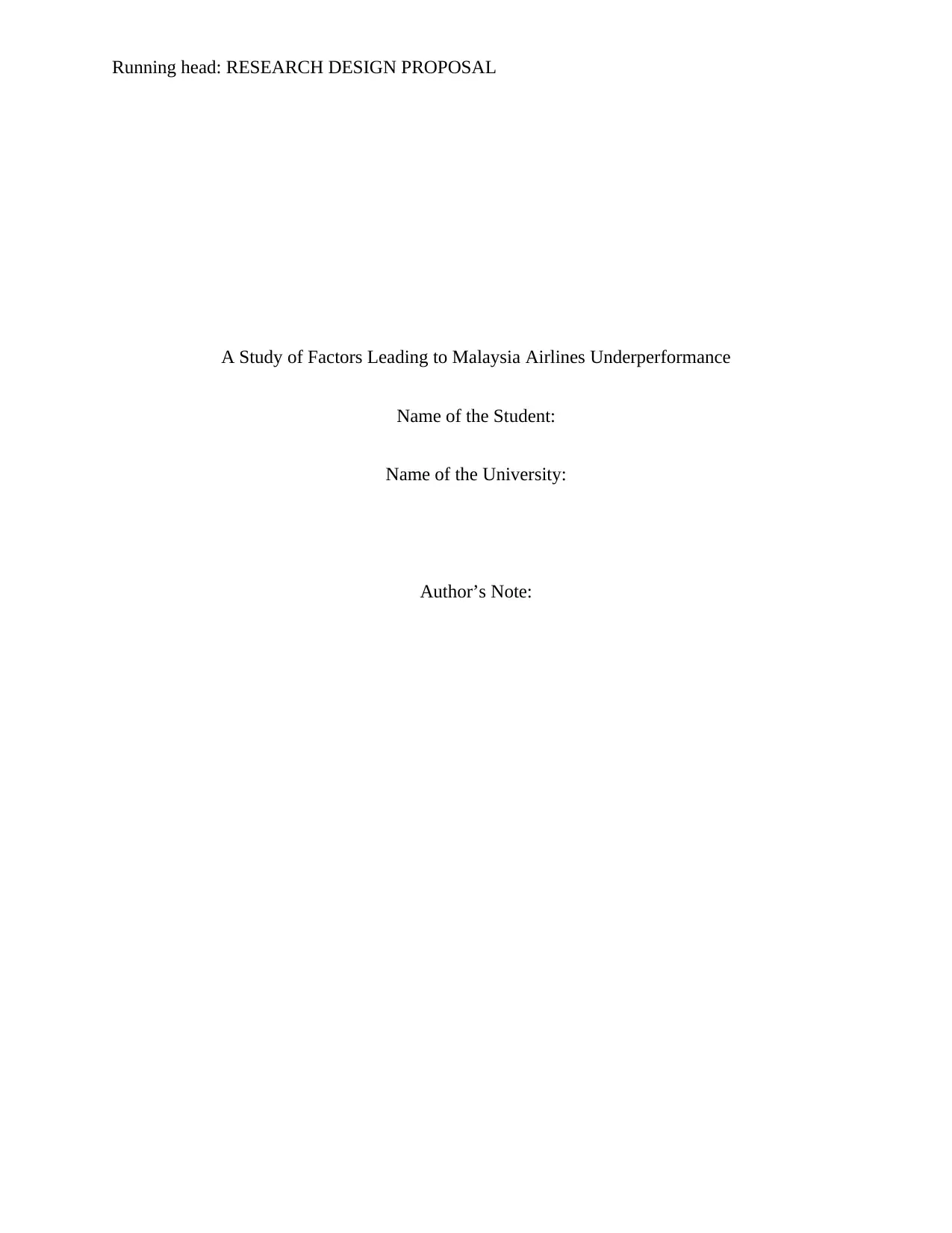
Running head: RESEARCH DESIGN PROPOSAL
A Study of Factors Leading to Malaysia Airlines Underperformance
Name of the Student:
Name of the University:
Author’s Note:
A Study of Factors Leading to Malaysia Airlines Underperformance
Name of the Student:
Name of the University:
Author’s Note:
Secure Best Marks with AI Grader
Need help grading? Try our AI Grader for instant feedback on your assignments.
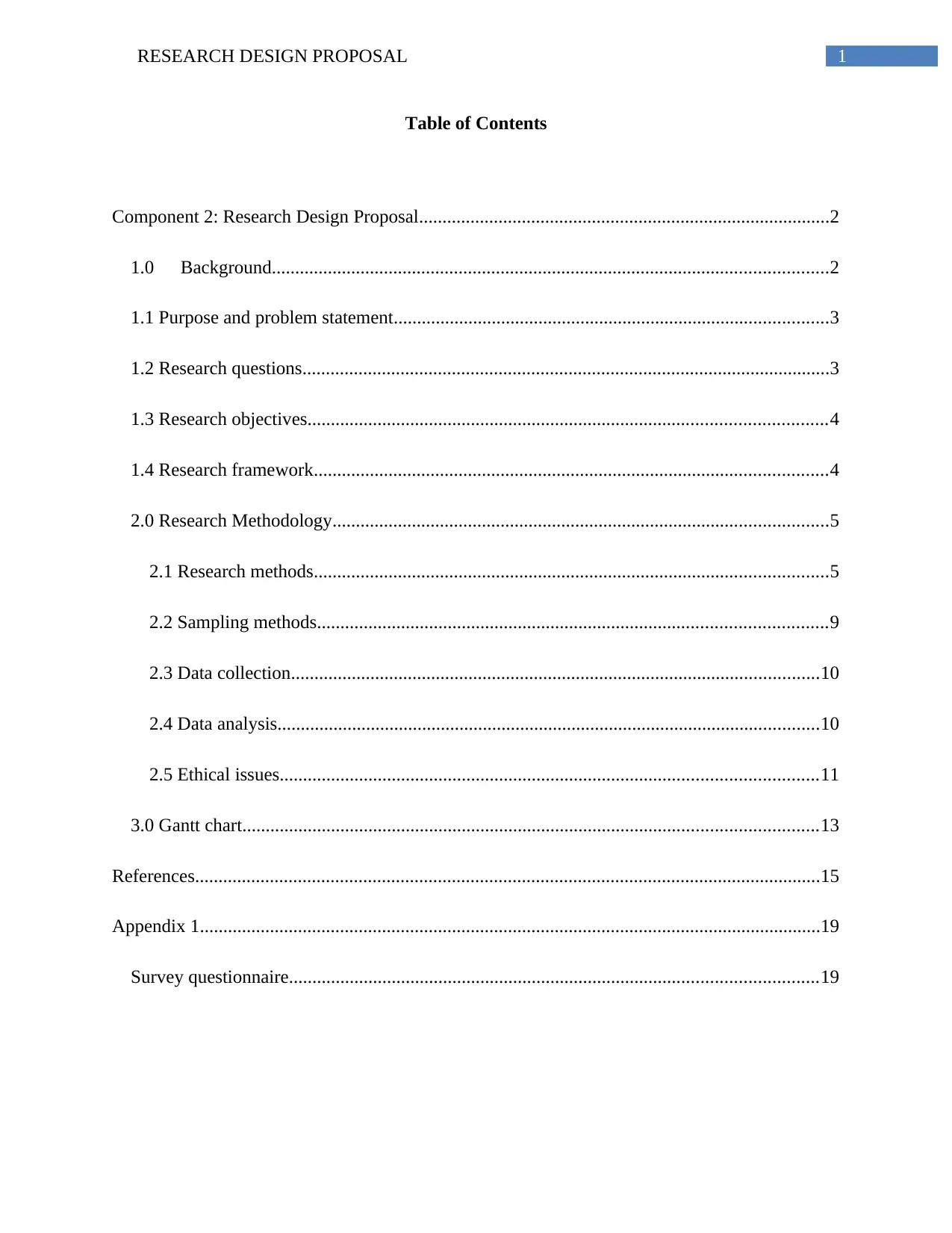
1RESEARCH DESIGN PROPOSAL
Table of Contents
Component 2: Research Design Proposal........................................................................................2
1.0 Background.......................................................................................................................2
1.1 Purpose and problem statement.............................................................................................3
1.2 Research questions.................................................................................................................3
1.3 Research objectives...............................................................................................................4
1.4 Research framework..............................................................................................................4
2.0 Research Methodology..........................................................................................................5
2.1 Research methods..............................................................................................................5
2.2 Sampling methods.............................................................................................................9
2.3 Data collection.................................................................................................................10
2.4 Data analysis....................................................................................................................10
2.5 Ethical issues...................................................................................................................11
3.0 Gantt chart...........................................................................................................................13
References......................................................................................................................................15
Appendix 1.....................................................................................................................................19
Survey questionnaire.................................................................................................................19
Table of Contents
Component 2: Research Design Proposal........................................................................................2
1.0 Background.......................................................................................................................2
1.1 Purpose and problem statement.............................................................................................3
1.2 Research questions.................................................................................................................3
1.3 Research objectives...............................................................................................................4
1.4 Research framework..............................................................................................................4
2.0 Research Methodology..........................................................................................................5
2.1 Research methods..............................................................................................................5
2.2 Sampling methods.............................................................................................................9
2.3 Data collection.................................................................................................................10
2.4 Data analysis....................................................................................................................10
2.5 Ethical issues...................................................................................................................11
3.0 Gantt chart...........................................................................................................................13
References......................................................................................................................................15
Appendix 1.....................................................................................................................................19
Survey questionnaire.................................................................................................................19
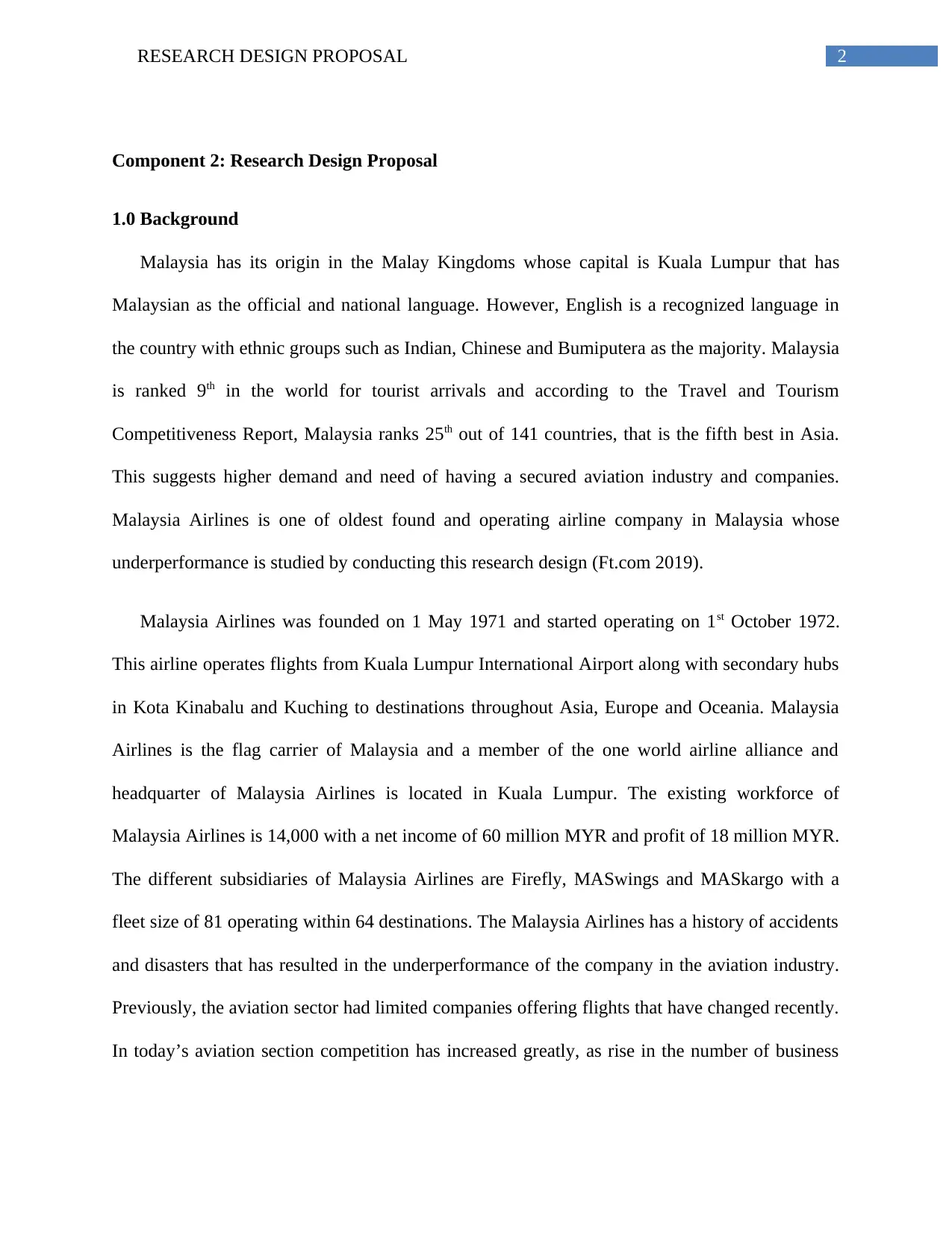
2RESEARCH DESIGN PROPOSAL
Component 2: Research Design Proposal
1.0 Background
Malaysia has its origin in the Malay Kingdoms whose capital is Kuala Lumpur that has
Malaysian as the official and national language. However, English is a recognized language in
the country with ethnic groups such as Indian, Chinese and Bumiputera as the majority. Malaysia
is ranked 9th in the world for tourist arrivals and according to the Travel and Tourism
Competitiveness Report, Malaysia ranks 25th out of 141 countries, that is the fifth best in Asia.
This suggests higher demand and need of having a secured aviation industry and companies.
Malaysia Airlines is one of oldest found and operating airline company in Malaysia whose
underperformance is studied by conducting this research design (Ft.com 2019).
Malaysia Airlines was founded on 1 May 1971 and started operating on 1st October 1972.
This airline operates flights from Kuala Lumpur International Airport along with secondary hubs
in Kota Kinabalu and Kuching to destinations throughout Asia, Europe and Oceania. Malaysia
Airlines is the flag carrier of Malaysia and a member of the one world airline alliance and
headquarter of Malaysia Airlines is located in Kuala Lumpur. The existing workforce of
Malaysia Airlines is 14,000 with a net income of 60 million MYR and profit of 18 million MYR.
The different subsidiaries of Malaysia Airlines are Firefly, MASwings and MASkargo with a
fleet size of 81 operating within 64 destinations. The Malaysia Airlines has a history of accidents
and disasters that has resulted in the underperformance of the company in the aviation industry.
Previously, the aviation sector had limited companies offering flights that have changed recently.
In today’s aviation section competition has increased greatly, as rise in the number of business
Component 2: Research Design Proposal
1.0 Background
Malaysia has its origin in the Malay Kingdoms whose capital is Kuala Lumpur that has
Malaysian as the official and national language. However, English is a recognized language in
the country with ethnic groups such as Indian, Chinese and Bumiputera as the majority. Malaysia
is ranked 9th in the world for tourist arrivals and according to the Travel and Tourism
Competitiveness Report, Malaysia ranks 25th out of 141 countries, that is the fifth best in Asia.
This suggests higher demand and need of having a secured aviation industry and companies.
Malaysia Airlines is one of oldest found and operating airline company in Malaysia whose
underperformance is studied by conducting this research design (Ft.com 2019).
Malaysia Airlines was founded on 1 May 1971 and started operating on 1st October 1972.
This airline operates flights from Kuala Lumpur International Airport along with secondary hubs
in Kota Kinabalu and Kuching to destinations throughout Asia, Europe and Oceania. Malaysia
Airlines is the flag carrier of Malaysia and a member of the one world airline alliance and
headquarter of Malaysia Airlines is located in Kuala Lumpur. The existing workforce of
Malaysia Airlines is 14,000 with a net income of 60 million MYR and profit of 18 million MYR.
The different subsidiaries of Malaysia Airlines are Firefly, MASwings and MASkargo with a
fleet size of 81 operating within 64 destinations. The Malaysia Airlines has a history of accidents
and disasters that has resulted in the underperformance of the company in the aviation industry.
Previously, the aviation sector had limited companies offering flights that have changed recently.
In today’s aviation section competition has increased greatly, as rise in the number of business
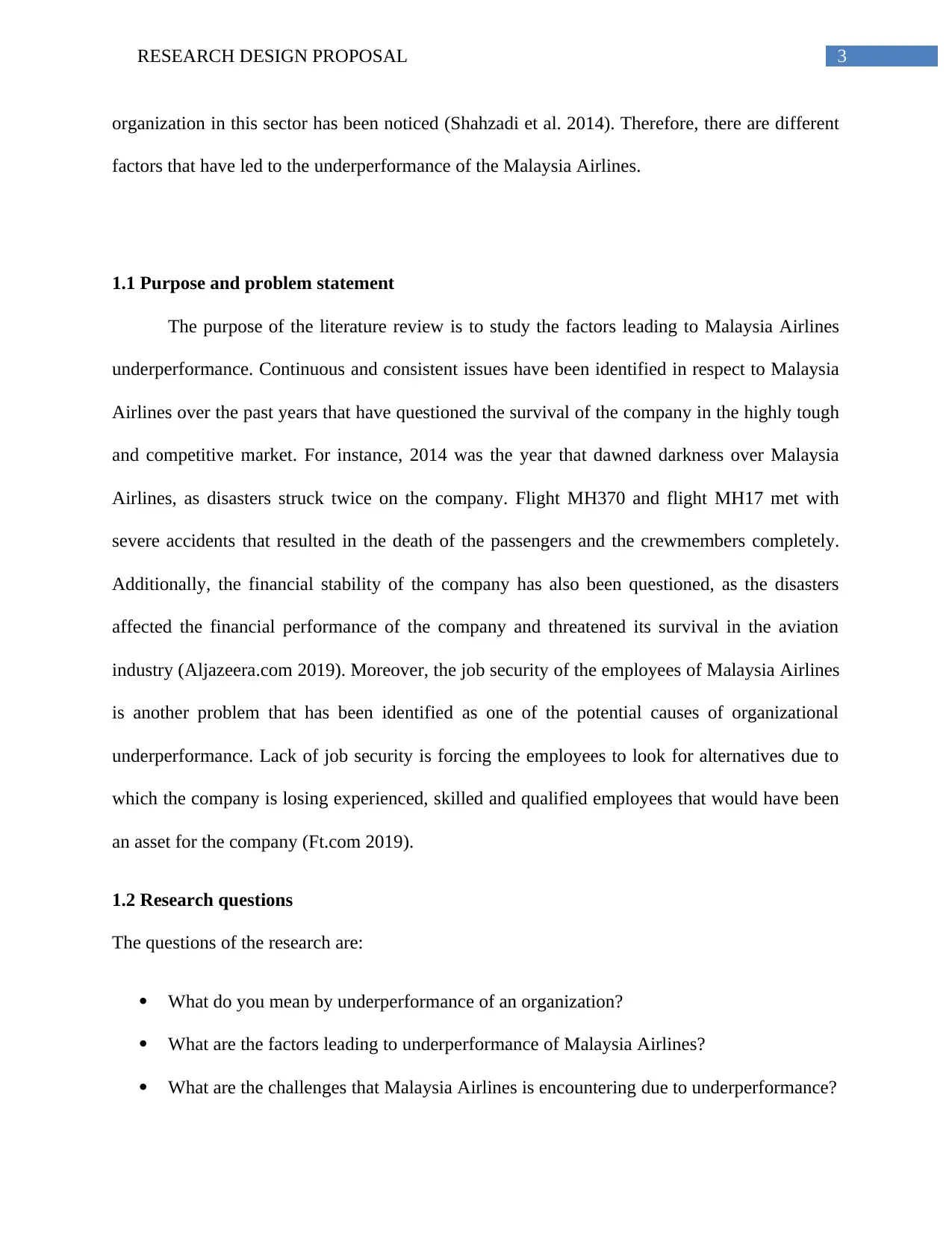
3RESEARCH DESIGN PROPOSAL
organization in this sector has been noticed (Shahzadi et al. 2014). Therefore, there are different
factors that have led to the underperformance of the Malaysia Airlines.
1.1 Purpose and problem statement
The purpose of the literature review is to study the factors leading to Malaysia Airlines
underperformance. Continuous and consistent issues have been identified in respect to Malaysia
Airlines over the past years that have questioned the survival of the company in the highly tough
and competitive market. For instance, 2014 was the year that dawned darkness over Malaysia
Airlines, as disasters struck twice on the company. Flight MH370 and flight MH17 met with
severe accidents that resulted in the death of the passengers and the crewmembers completely.
Additionally, the financial stability of the company has also been questioned, as the disasters
affected the financial performance of the company and threatened its survival in the aviation
industry (Aljazeera.com 2019). Moreover, the job security of the employees of Malaysia Airlines
is another problem that has been identified as one of the potential causes of organizational
underperformance. Lack of job security is forcing the employees to look for alternatives due to
which the company is losing experienced, skilled and qualified employees that would have been
an asset for the company (Ft.com 2019).
1.2 Research questions
The questions of the research are:
What do you mean by underperformance of an organization?
What are the factors leading to underperformance of Malaysia Airlines?
What are the challenges that Malaysia Airlines is encountering due to underperformance?
organization in this sector has been noticed (Shahzadi et al. 2014). Therefore, there are different
factors that have led to the underperformance of the Malaysia Airlines.
1.1 Purpose and problem statement
The purpose of the literature review is to study the factors leading to Malaysia Airlines
underperformance. Continuous and consistent issues have been identified in respect to Malaysia
Airlines over the past years that have questioned the survival of the company in the highly tough
and competitive market. For instance, 2014 was the year that dawned darkness over Malaysia
Airlines, as disasters struck twice on the company. Flight MH370 and flight MH17 met with
severe accidents that resulted in the death of the passengers and the crewmembers completely.
Additionally, the financial stability of the company has also been questioned, as the disasters
affected the financial performance of the company and threatened its survival in the aviation
industry (Aljazeera.com 2019). Moreover, the job security of the employees of Malaysia Airlines
is another problem that has been identified as one of the potential causes of organizational
underperformance. Lack of job security is forcing the employees to look for alternatives due to
which the company is losing experienced, skilled and qualified employees that would have been
an asset for the company (Ft.com 2019).
1.2 Research questions
The questions of the research are:
What do you mean by underperformance of an organization?
What are the factors leading to underperformance of Malaysia Airlines?
What are the challenges that Malaysia Airlines is encountering due to underperformance?
Secure Best Marks with AI Grader
Need help grading? Try our AI Grader for instant feedback on your assignments.
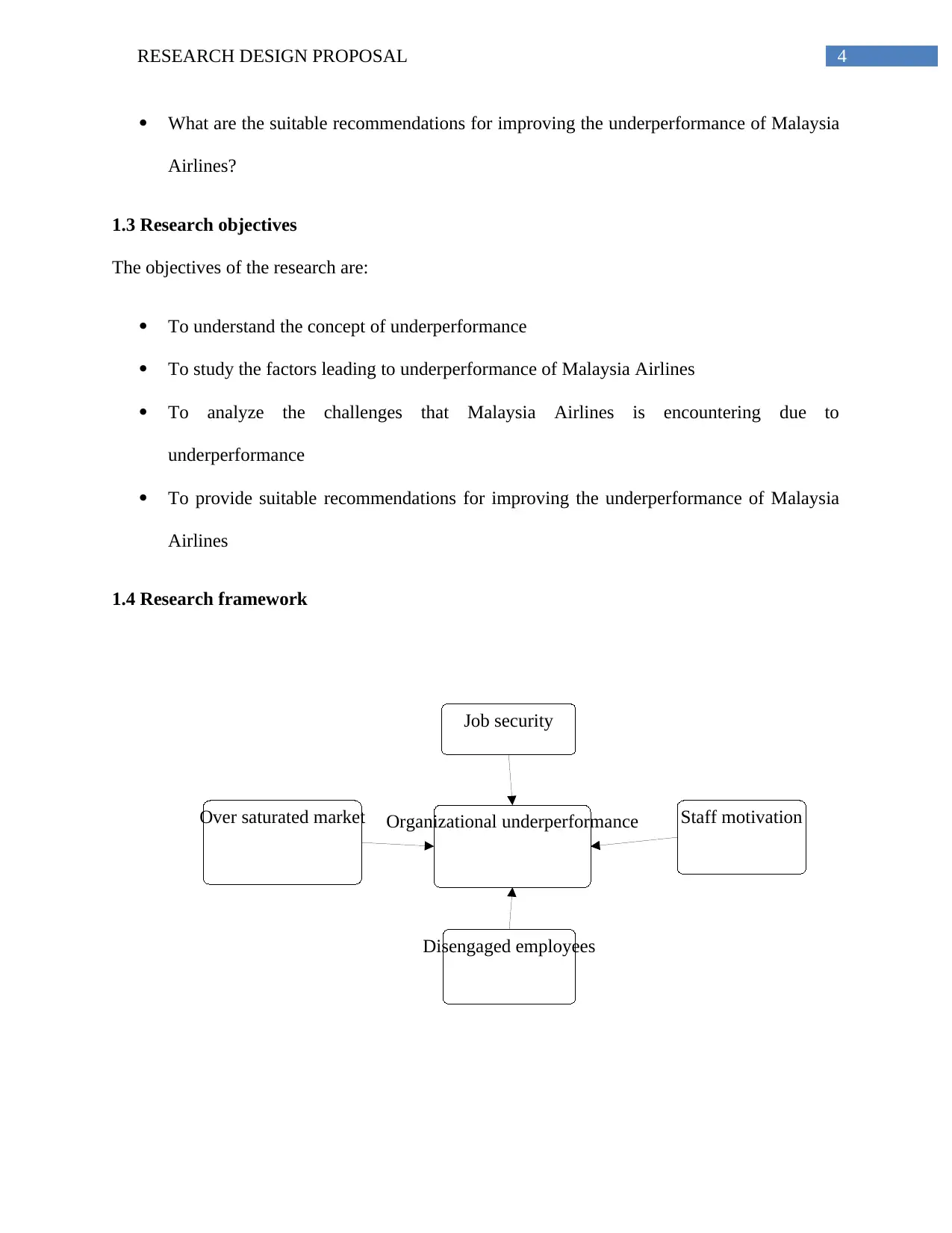
4RESEARCH DESIGN PROPOSAL
Organizational underperformance
Job security
Disengaged employees
Staff motivationOver saturated market
What are the suitable recommendations for improving the underperformance of Malaysia
Airlines?
1.3 Research objectives
The objectives of the research are:
To understand the concept of underperformance
To study the factors leading to underperformance of Malaysia Airlines
To analyze the challenges that Malaysia Airlines is encountering due to
underperformance
To provide suitable recommendations for improving the underperformance of Malaysia
Airlines
1.4 Research framework
Organizational underperformance
Job security
Disengaged employees
Staff motivationOver saturated market
What are the suitable recommendations for improving the underperformance of Malaysia
Airlines?
1.3 Research objectives
The objectives of the research are:
To understand the concept of underperformance
To study the factors leading to underperformance of Malaysia Airlines
To analyze the challenges that Malaysia Airlines is encountering due to
underperformance
To provide suitable recommendations for improving the underperformance of Malaysia
Airlines
1.4 Research framework

5RESEARCH DESIGN PROPOSAL
Research framework
(Source: Created by the Author)
2.0 Research Methodology
2.1 Research methods
The research method chapter is developed with the aim of shedding light on the different
methodological tools those are considered while undertaking a research. As a result, this chapter
will provide a brief overview of the existing types of methodological tools that will be used for a
research. The researcher has to emphasize on the philosophical stances, designs, strategies and
approach and research administrations for undertaking the study in a conclusive and authentic
manner. In addition to, this section will highlight the most suitable data collection method that
will help in improving the quality of the study conducted. Moreover, the section also justifies the
selection of the specific research methodologies that intend to help study the factors that led to
the underperformance of Malaysia Airlines.
Research philosophy
Research philosophies is defined as the set of approaches that facilitates the collection of
relevant data for undertaking the study. Three main philosophies those are used for undertaking a
research and completing it successfully includes positivism, pragmatism and interpretivism. As
mentioned by Kumar (2019), positivism philosophy facilitates observing and describing specific
phenomenon from the viewpoint of the research objectives. Due to this, it is necessary to restrict
the interference of the phenomenon in the study. This provides an opportunity to restrict
repetition of the observation. Additionally, positivism philosophy allows using logic and facts for
developing knowledge and making observations. On the other hand, pragmatism philosophy
Research framework
(Source: Created by the Author)
2.0 Research Methodology
2.1 Research methods
The research method chapter is developed with the aim of shedding light on the different
methodological tools those are considered while undertaking a research. As a result, this chapter
will provide a brief overview of the existing types of methodological tools that will be used for a
research. The researcher has to emphasize on the philosophical stances, designs, strategies and
approach and research administrations for undertaking the study in a conclusive and authentic
manner. In addition to, this section will highlight the most suitable data collection method that
will help in improving the quality of the study conducted. Moreover, the section also justifies the
selection of the specific research methodologies that intend to help study the factors that led to
the underperformance of Malaysia Airlines.
Research philosophy
Research philosophies is defined as the set of approaches that facilitates the collection of
relevant data for undertaking the study. Three main philosophies those are used for undertaking a
research and completing it successfully includes positivism, pragmatism and interpretivism. As
mentioned by Kumar (2019), positivism philosophy facilitates observing and describing specific
phenomenon from the viewpoint of the research objectives. Due to this, it is necessary to restrict
the interference of the phenomenon in the study. This provides an opportunity to restrict
repetition of the observation. Additionally, positivism philosophy allows using logic and facts for
developing knowledge and making observations. On the other hand, pragmatism philosophy
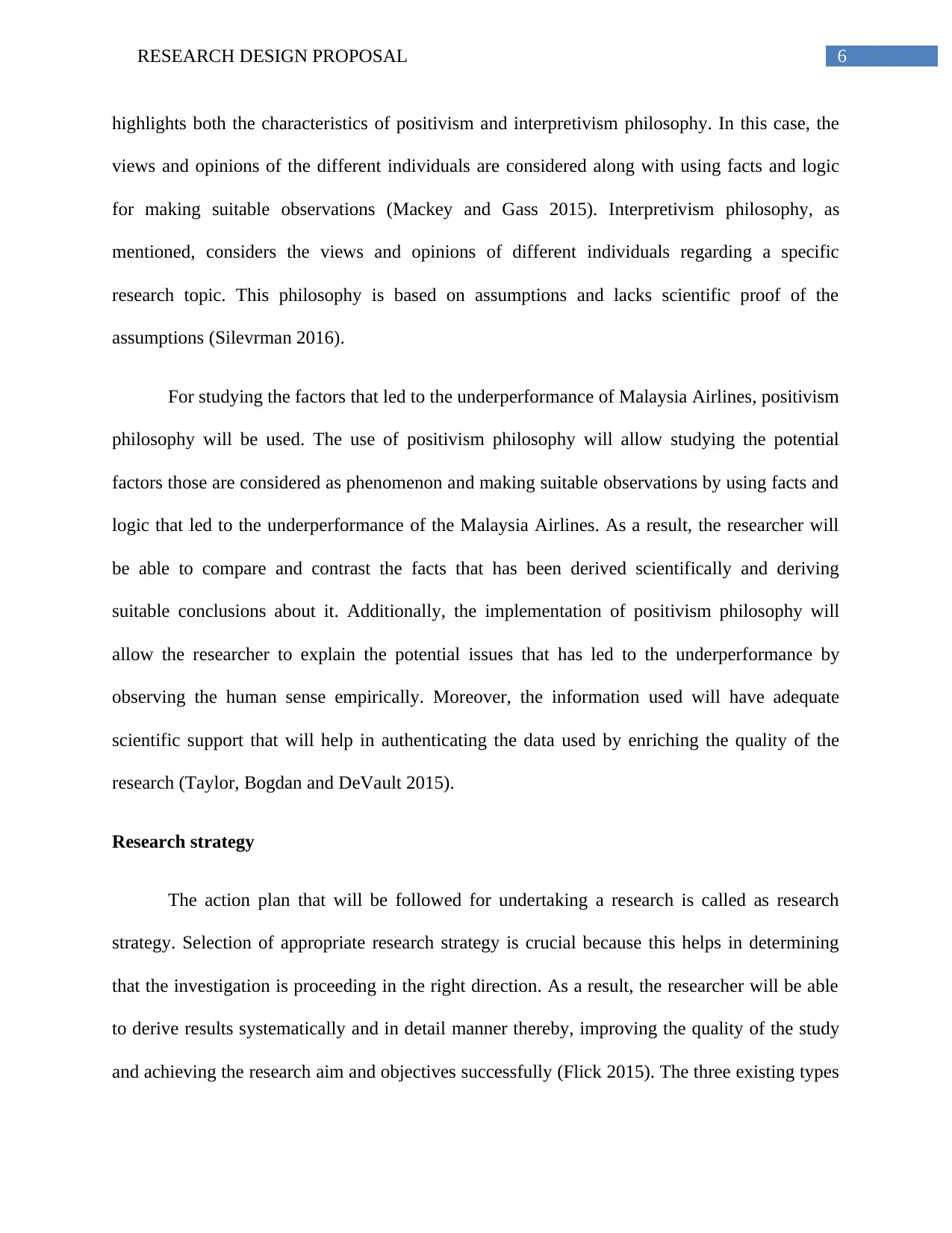
6RESEARCH DESIGN PROPOSAL
highlights both the characteristics of positivism and interpretivism philosophy. In this case, the
views and opinions of the different individuals are considered along with using facts and logic
for making suitable observations (Mackey and Gass 2015). Interpretivism philosophy, as
mentioned, considers the views and opinions of different individuals regarding a specific
research topic. This philosophy is based on assumptions and lacks scientific proof of the
assumptions (Silevrman 2016).
For studying the factors that led to the underperformance of Malaysia Airlines, positivism
philosophy will be used. The use of positivism philosophy will allow studying the potential
factors those are considered as phenomenon and making suitable observations by using facts and
logic that led to the underperformance of the Malaysia Airlines. As a result, the researcher will
be able to compare and contrast the facts that has been derived scientifically and deriving
suitable conclusions about it. Additionally, the implementation of positivism philosophy will
allow the researcher to explain the potential issues that has led to the underperformance by
observing the human sense empirically. Moreover, the information used will have adequate
scientific support that will help in authenticating the data used by enriching the quality of the
research (Taylor, Bogdan and DeVault 2015).
Research strategy
The action plan that will be followed for undertaking a research is called as research
strategy. Selection of appropriate research strategy is crucial because this helps in determining
that the investigation is proceeding in the right direction. As a result, the researcher will be able
to derive results systematically and in detail manner thereby, improving the quality of the study
and achieving the research aim and objectives successfully (Flick 2015). The three existing types
highlights both the characteristics of positivism and interpretivism philosophy. In this case, the
views and opinions of the different individuals are considered along with using facts and logic
for making suitable observations (Mackey and Gass 2015). Interpretivism philosophy, as
mentioned, considers the views and opinions of different individuals regarding a specific
research topic. This philosophy is based on assumptions and lacks scientific proof of the
assumptions (Silevrman 2016).
For studying the factors that led to the underperformance of Malaysia Airlines, positivism
philosophy will be used. The use of positivism philosophy will allow studying the potential
factors those are considered as phenomenon and making suitable observations by using facts and
logic that led to the underperformance of the Malaysia Airlines. As a result, the researcher will
be able to compare and contrast the facts that has been derived scientifically and deriving
suitable conclusions about it. Additionally, the implementation of positivism philosophy will
allow the researcher to explain the potential issues that has led to the underperformance by
observing the human sense empirically. Moreover, the information used will have adequate
scientific support that will help in authenticating the data used by enriching the quality of the
research (Taylor, Bogdan and DeVault 2015).
Research strategy
The action plan that will be followed for undertaking a research is called as research
strategy. Selection of appropriate research strategy is crucial because this helps in determining
that the investigation is proceeding in the right direction. As a result, the researcher will be able
to derive results systematically and in detail manner thereby, improving the quality of the study
and achieving the research aim and objectives successfully (Flick 2015). The three existing types
Paraphrase This Document
Need a fresh take? Get an instant paraphrase of this document with our AI Paraphraser
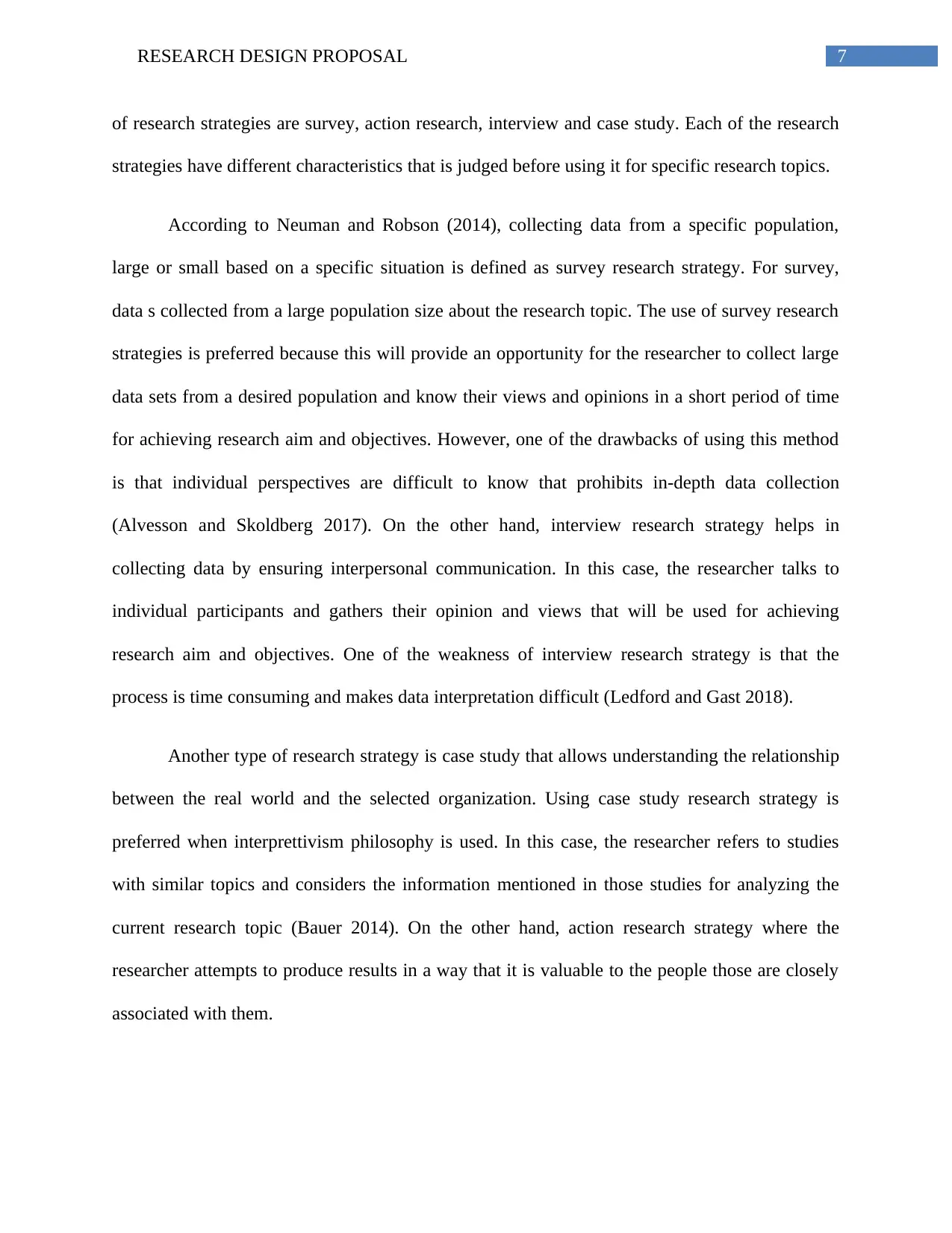
7RESEARCH DESIGN PROPOSAL
of research strategies are survey, action research, interview and case study. Each of the research
strategies have different characteristics that is judged before using it for specific research topics.
According to Neuman and Robson (2014), collecting data from a specific population,
large or small based on a specific situation is defined as survey research strategy. For survey,
data s collected from a large population size about the research topic. The use of survey research
strategies is preferred because this will provide an opportunity for the researcher to collect large
data sets from a desired population and know their views and opinions in a short period of time
for achieving research aim and objectives. However, one of the drawbacks of using this method
is that individual perspectives are difficult to know that prohibits in-depth data collection
(Alvesson and Skoldberg 2017). On the other hand, interview research strategy helps in
collecting data by ensuring interpersonal communication. In this case, the researcher talks to
individual participants and gathers their opinion and views that will be used for achieving
research aim and objectives. One of the weakness of interview research strategy is that the
process is time consuming and makes data interpretation difficult (Ledford and Gast 2018).
Another type of research strategy is case study that allows understanding the relationship
between the real world and the selected organization. Using case study research strategy is
preferred when interprettivism philosophy is used. In this case, the researcher refers to studies
with similar topics and considers the information mentioned in those studies for analyzing the
current research topic (Bauer 2014). On the other hand, action research strategy where the
researcher attempts to produce results in a way that it is valuable to the people those are closely
associated with them.
of research strategies are survey, action research, interview and case study. Each of the research
strategies have different characteristics that is judged before using it for specific research topics.
According to Neuman and Robson (2014), collecting data from a specific population,
large or small based on a specific situation is defined as survey research strategy. For survey,
data s collected from a large population size about the research topic. The use of survey research
strategies is preferred because this will provide an opportunity for the researcher to collect large
data sets from a desired population and know their views and opinions in a short period of time
for achieving research aim and objectives. However, one of the drawbacks of using this method
is that individual perspectives are difficult to know that prohibits in-depth data collection
(Alvesson and Skoldberg 2017). On the other hand, interview research strategy helps in
collecting data by ensuring interpersonal communication. In this case, the researcher talks to
individual participants and gathers their opinion and views that will be used for achieving
research aim and objectives. One of the weakness of interview research strategy is that the
process is time consuming and makes data interpretation difficult (Ledford and Gast 2018).
Another type of research strategy is case study that allows understanding the relationship
between the real world and the selected organization. Using case study research strategy is
preferred when interprettivism philosophy is used. In this case, the researcher refers to studies
with similar topics and considers the information mentioned in those studies for analyzing the
current research topic (Bauer 2014). On the other hand, action research strategy where the
researcher attempts to produce results in a way that it is valuable to the people those are closely
associated with them.
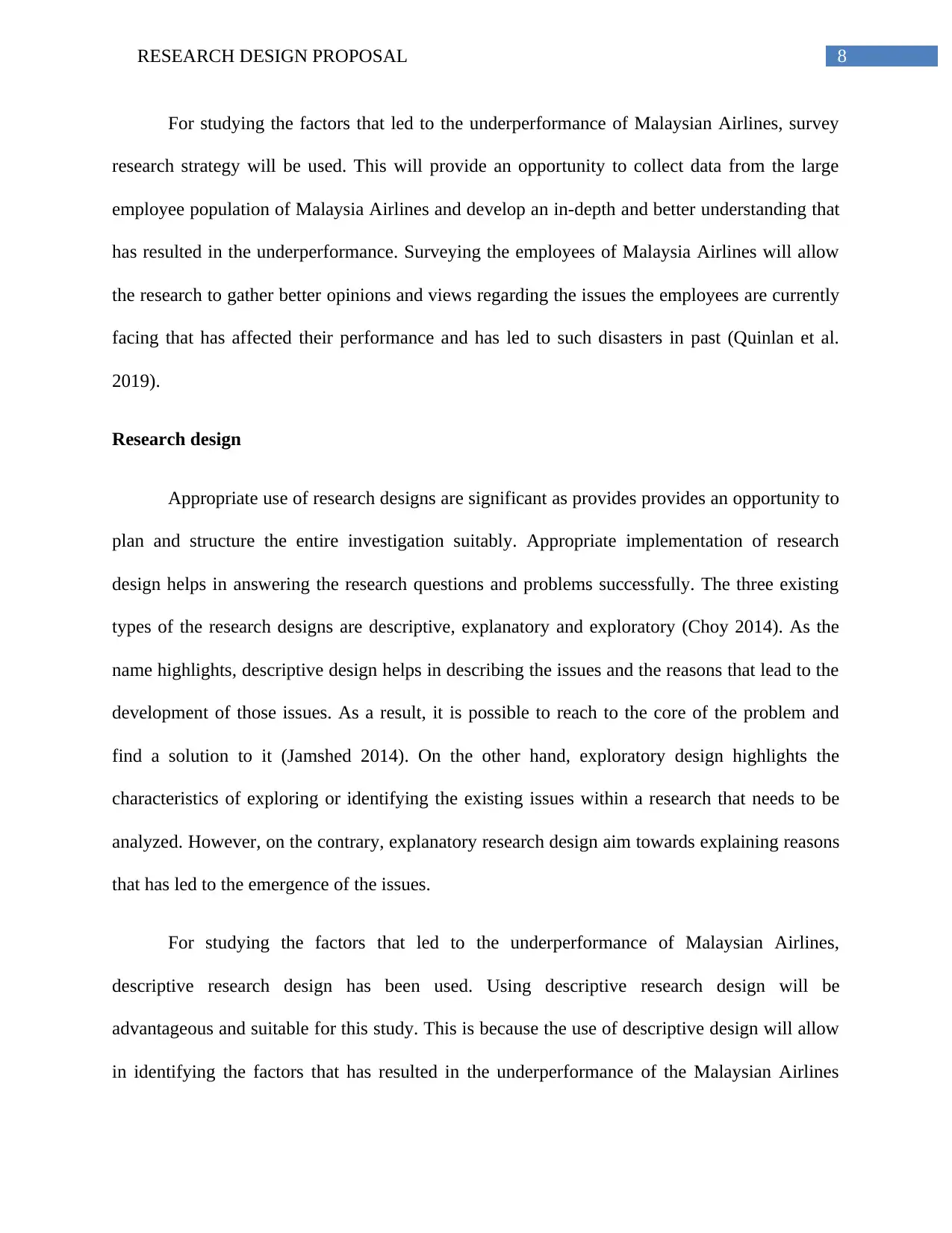
8RESEARCH DESIGN PROPOSAL
For studying the factors that led to the underperformance of Malaysian Airlines, survey
research strategy will be used. This will provide an opportunity to collect data from the large
employee population of Malaysia Airlines and develop an in-depth and better understanding that
has resulted in the underperformance. Surveying the employees of Malaysia Airlines will allow
the research to gather better opinions and views regarding the issues the employees are currently
facing that has affected their performance and has led to such disasters in past (Quinlan et al.
2019).
Research design
Appropriate use of research designs are significant as provides provides an opportunity to
plan and structure the entire investigation suitably. Appropriate implementation of research
design helps in answering the research questions and problems successfully. The three existing
types of the research designs are descriptive, explanatory and exploratory (Choy 2014). As the
name highlights, descriptive design helps in describing the issues and the reasons that lead to the
development of those issues. As a result, it is possible to reach to the core of the problem and
find a solution to it (Jamshed 2014). On the other hand, exploratory design highlights the
characteristics of exploring or identifying the existing issues within a research that needs to be
analyzed. However, on the contrary, explanatory research design aim towards explaining reasons
that has led to the emergence of the issues.
For studying the factors that led to the underperformance of Malaysian Airlines,
descriptive research design has been used. Using descriptive research design will be
advantageous and suitable for this study. This is because the use of descriptive design will allow
in identifying the factors that has resulted in the underperformance of the Malaysian Airlines
For studying the factors that led to the underperformance of Malaysian Airlines, survey
research strategy will be used. This will provide an opportunity to collect data from the large
employee population of Malaysia Airlines and develop an in-depth and better understanding that
has resulted in the underperformance. Surveying the employees of Malaysia Airlines will allow
the research to gather better opinions and views regarding the issues the employees are currently
facing that has affected their performance and has led to such disasters in past (Quinlan et al.
2019).
Research design
Appropriate use of research designs are significant as provides provides an opportunity to
plan and structure the entire investigation suitably. Appropriate implementation of research
design helps in answering the research questions and problems successfully. The three existing
types of the research designs are descriptive, explanatory and exploratory (Choy 2014). As the
name highlights, descriptive design helps in describing the issues and the reasons that lead to the
development of those issues. As a result, it is possible to reach to the core of the problem and
find a solution to it (Jamshed 2014). On the other hand, exploratory design highlights the
characteristics of exploring or identifying the existing issues within a research that needs to be
analyzed. However, on the contrary, explanatory research design aim towards explaining reasons
that has led to the emergence of the issues.
For studying the factors that led to the underperformance of Malaysian Airlines,
descriptive research design has been used. Using descriptive research design will be
advantageous and suitable for this study. This is because the use of descriptive design will allow
in identifying the factors that has resulted in the underperformance of the Malaysian Airlines
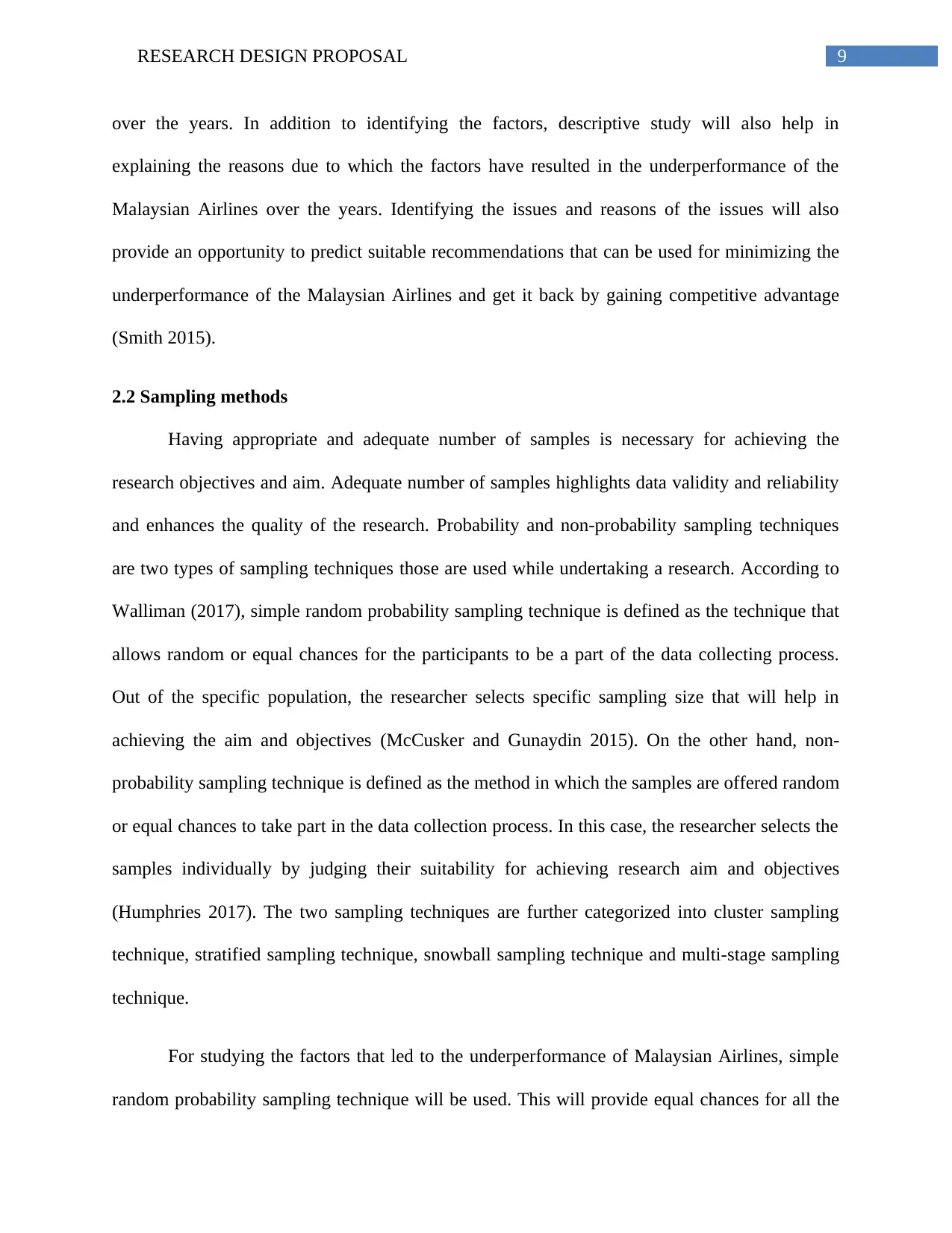
9RESEARCH DESIGN PROPOSAL
over the years. In addition to identifying the factors, descriptive study will also help in
explaining the reasons due to which the factors have resulted in the underperformance of the
Malaysian Airlines over the years. Identifying the issues and reasons of the issues will also
provide an opportunity to predict suitable recommendations that can be used for minimizing the
underperformance of the Malaysian Airlines and get it back by gaining competitive advantage
(Smith 2015).
2.2 Sampling methods
Having appropriate and adequate number of samples is necessary for achieving the
research objectives and aim. Adequate number of samples highlights data validity and reliability
and enhances the quality of the research. Probability and non-probability sampling techniques
are two types of sampling techniques those are used while undertaking a research. According to
Walliman (2017), simple random probability sampling technique is defined as the technique that
allows random or equal chances for the participants to be a part of the data collecting process.
Out of the specific population, the researcher selects specific sampling size that will help in
achieving the aim and objectives (McCusker and Gunaydin 2015). On the other hand, non-
probability sampling technique is defined as the method in which the samples are offered random
or equal chances to take part in the data collection process. In this case, the researcher selects the
samples individually by judging their suitability for achieving research aim and objectives
(Humphries 2017). The two sampling techniques are further categorized into cluster sampling
technique, stratified sampling technique, snowball sampling technique and multi-stage sampling
technique.
For studying the factors that led to the underperformance of Malaysian Airlines, simple
random probability sampling technique will be used. This will provide equal chances for all the
over the years. In addition to identifying the factors, descriptive study will also help in
explaining the reasons due to which the factors have resulted in the underperformance of the
Malaysian Airlines over the years. Identifying the issues and reasons of the issues will also
provide an opportunity to predict suitable recommendations that can be used for minimizing the
underperformance of the Malaysian Airlines and get it back by gaining competitive advantage
(Smith 2015).
2.2 Sampling methods
Having appropriate and adequate number of samples is necessary for achieving the
research objectives and aim. Adequate number of samples highlights data validity and reliability
and enhances the quality of the research. Probability and non-probability sampling techniques
are two types of sampling techniques those are used while undertaking a research. According to
Walliman (2017), simple random probability sampling technique is defined as the technique that
allows random or equal chances for the participants to be a part of the data collecting process.
Out of the specific population, the researcher selects specific sampling size that will help in
achieving the aim and objectives (McCusker and Gunaydin 2015). On the other hand, non-
probability sampling technique is defined as the method in which the samples are offered random
or equal chances to take part in the data collection process. In this case, the researcher selects the
samples individually by judging their suitability for achieving research aim and objectives
(Humphries 2017). The two sampling techniques are further categorized into cluster sampling
technique, stratified sampling technique, snowball sampling technique and multi-stage sampling
technique.
For studying the factors that led to the underperformance of Malaysian Airlines, simple
random probability sampling technique will be used. This will provide equal chances for all the
Secure Best Marks with AI Grader
Need help grading? Try our AI Grader for instant feedback on your assignments.
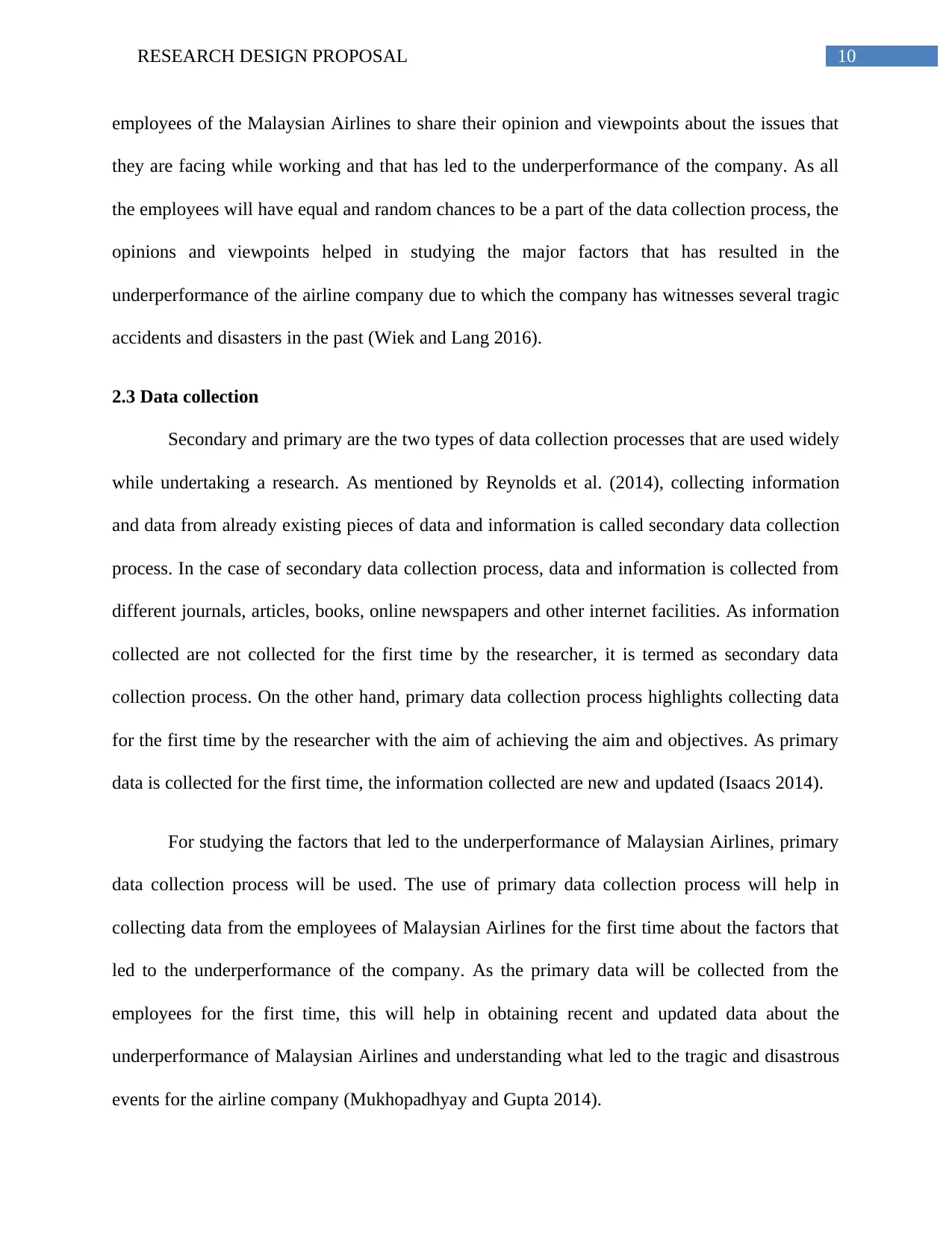
10RESEARCH DESIGN PROPOSAL
employees of the Malaysian Airlines to share their opinion and viewpoints about the issues that
they are facing while working and that has led to the underperformance of the company. As all
the employees will have equal and random chances to be a part of the data collection process, the
opinions and viewpoints helped in studying the major factors that has resulted in the
underperformance of the airline company due to which the company has witnesses several tragic
accidents and disasters in the past (Wiek and Lang 2016).
2.3 Data collection
Secondary and primary are the two types of data collection processes that are used widely
while undertaking a research. As mentioned by Reynolds et al. (2014), collecting information
and data from already existing pieces of data and information is called secondary data collection
process. In the case of secondary data collection process, data and information is collected from
different journals, articles, books, online newspapers and other internet facilities. As information
collected are not collected for the first time by the researcher, it is termed as secondary data
collection process. On the other hand, primary data collection process highlights collecting data
for the first time by the researcher with the aim of achieving the aim and objectives. As primary
data is collected for the first time, the information collected are new and updated (Isaacs 2014).
For studying the factors that led to the underperformance of Malaysian Airlines, primary
data collection process will be used. The use of primary data collection process will help in
collecting data from the employees of Malaysian Airlines for the first time about the factors that
led to the underperformance of the company. As the primary data will be collected from the
employees for the first time, this will help in obtaining recent and updated data about the
underperformance of Malaysian Airlines and understanding what led to the tragic and disastrous
events for the airline company (Mukhopadhyay and Gupta 2014).
employees of the Malaysian Airlines to share their opinion and viewpoints about the issues that
they are facing while working and that has led to the underperformance of the company. As all
the employees will have equal and random chances to be a part of the data collection process, the
opinions and viewpoints helped in studying the major factors that has resulted in the
underperformance of the airline company due to which the company has witnesses several tragic
accidents and disasters in the past (Wiek and Lang 2016).
2.3 Data collection
Secondary and primary are the two types of data collection processes that are used widely
while undertaking a research. As mentioned by Reynolds et al. (2014), collecting information
and data from already existing pieces of data and information is called secondary data collection
process. In the case of secondary data collection process, data and information is collected from
different journals, articles, books, online newspapers and other internet facilities. As information
collected are not collected for the first time by the researcher, it is termed as secondary data
collection process. On the other hand, primary data collection process highlights collecting data
for the first time by the researcher with the aim of achieving the aim and objectives. As primary
data is collected for the first time, the information collected are new and updated (Isaacs 2014).
For studying the factors that led to the underperformance of Malaysian Airlines, primary
data collection process will be used. The use of primary data collection process will help in
collecting data from the employees of Malaysian Airlines for the first time about the factors that
led to the underperformance of the company. As the primary data will be collected from the
employees for the first time, this will help in obtaining recent and updated data about the
underperformance of Malaysian Airlines and understanding what led to the tragic and disastrous
events for the airline company (Mukhopadhyay and Gupta 2014).
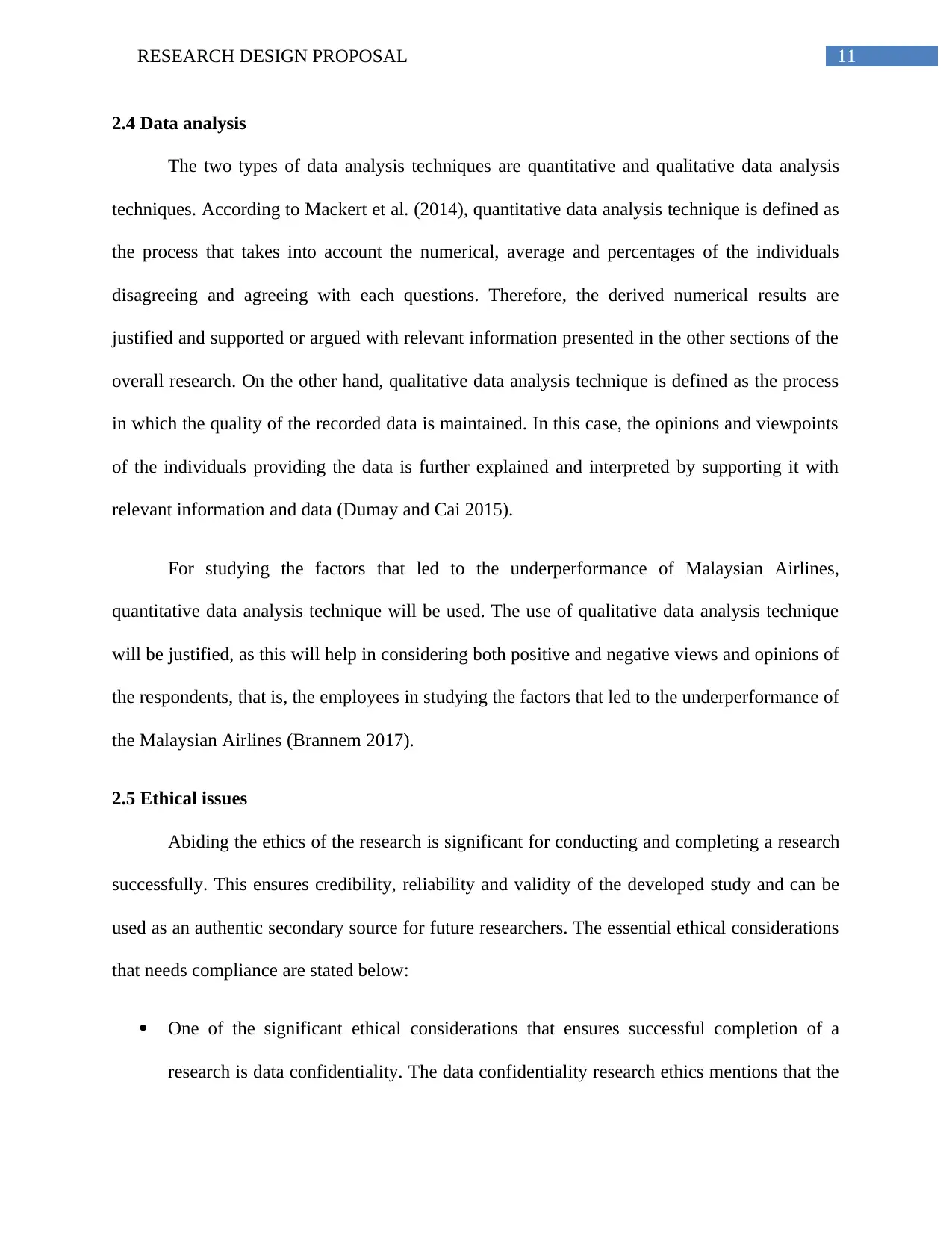
11RESEARCH DESIGN PROPOSAL
2.4 Data analysis
The two types of data analysis techniques are quantitative and qualitative data analysis
techniques. According to Mackert et al. (2014), quantitative data analysis technique is defined as
the process that takes into account the numerical, average and percentages of the individuals
disagreeing and agreeing with each questions. Therefore, the derived numerical results are
justified and supported or argued with relevant information presented in the other sections of the
overall research. On the other hand, qualitative data analysis technique is defined as the process
in which the quality of the recorded data is maintained. In this case, the opinions and viewpoints
of the individuals providing the data is further explained and interpreted by supporting it with
relevant information and data (Dumay and Cai 2015).
For studying the factors that led to the underperformance of Malaysian Airlines,
quantitative data analysis technique will be used. The use of qualitative data analysis technique
will be justified, as this will help in considering both positive and negative views and opinions of
the respondents, that is, the employees in studying the factors that led to the underperformance of
the Malaysian Airlines (Brannem 2017).
2.5 Ethical issues
Abiding the ethics of the research is significant for conducting and completing a research
successfully. This ensures credibility, reliability and validity of the developed study and can be
used as an authentic secondary source for future researchers. The essential ethical considerations
that needs compliance are stated below:
One of the significant ethical considerations that ensures successful completion of a
research is data confidentiality. The data confidentiality research ethics mentions that the
2.4 Data analysis
The two types of data analysis techniques are quantitative and qualitative data analysis
techniques. According to Mackert et al. (2014), quantitative data analysis technique is defined as
the process that takes into account the numerical, average and percentages of the individuals
disagreeing and agreeing with each questions. Therefore, the derived numerical results are
justified and supported or argued with relevant information presented in the other sections of the
overall research. On the other hand, qualitative data analysis technique is defined as the process
in which the quality of the recorded data is maintained. In this case, the opinions and viewpoints
of the individuals providing the data is further explained and interpreted by supporting it with
relevant information and data (Dumay and Cai 2015).
For studying the factors that led to the underperformance of Malaysian Airlines,
quantitative data analysis technique will be used. The use of qualitative data analysis technique
will be justified, as this will help in considering both positive and negative views and opinions of
the respondents, that is, the employees in studying the factors that led to the underperformance of
the Malaysian Airlines (Brannem 2017).
2.5 Ethical issues
Abiding the ethics of the research is significant for conducting and completing a research
successfully. This ensures credibility, reliability and validity of the developed study and can be
used as an authentic secondary source for future researchers. The essential ethical considerations
that needs compliance are stated below:
One of the significant ethical considerations that ensures successful completion of a
research is data confidentiality. The data confidentiality research ethics mentions that the
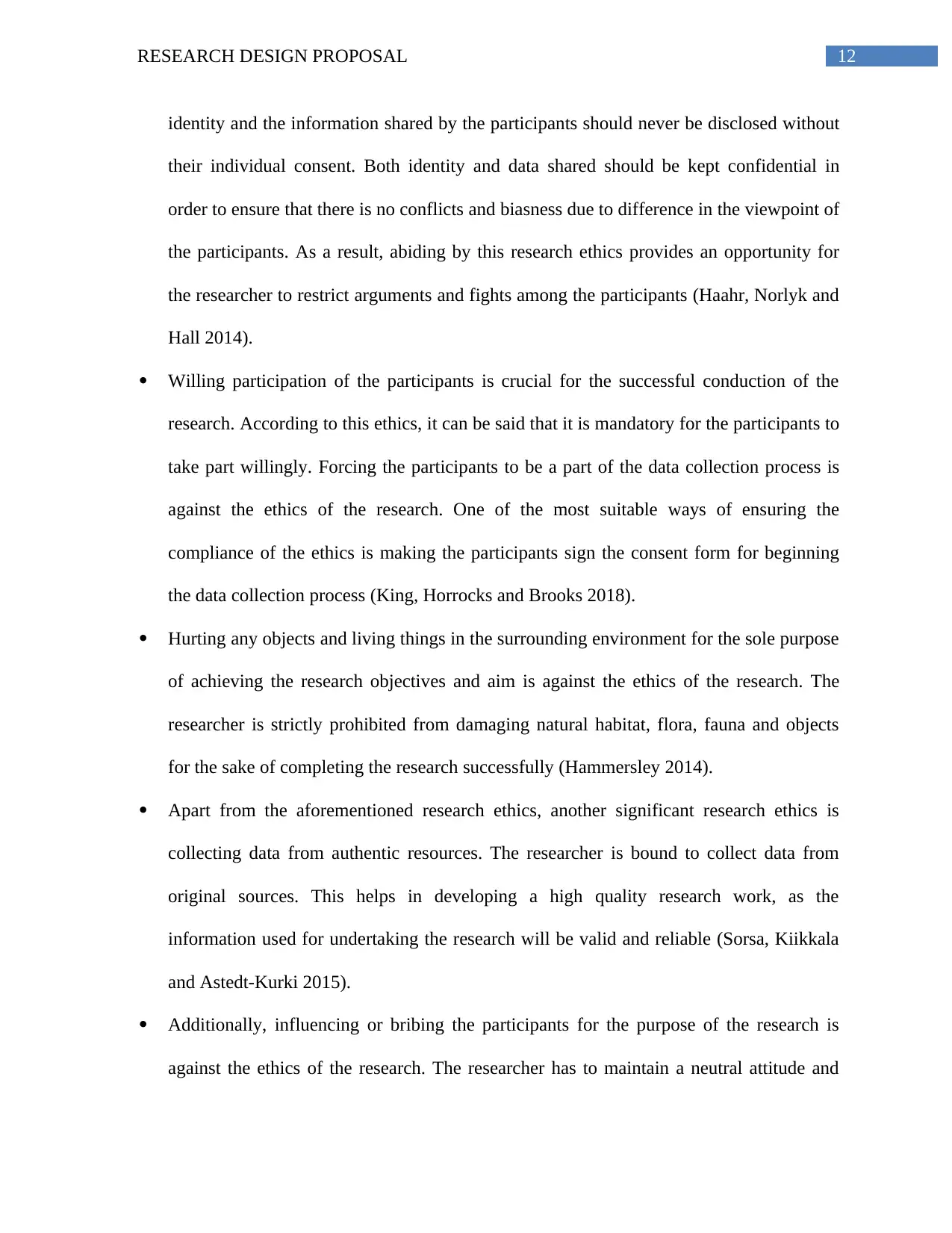
12RESEARCH DESIGN PROPOSAL
identity and the information shared by the participants should never be disclosed without
their individual consent. Both identity and data shared should be kept confidential in
order to ensure that there is no conflicts and biasness due to difference in the viewpoint of
the participants. As a result, abiding by this research ethics provides an opportunity for
the researcher to restrict arguments and fights among the participants (Haahr, Norlyk and
Hall 2014).
Willing participation of the participants is crucial for the successful conduction of the
research. According to this ethics, it can be said that it is mandatory for the participants to
take part willingly. Forcing the participants to be a part of the data collection process is
against the ethics of the research. One of the most suitable ways of ensuring the
compliance of the ethics is making the participants sign the consent form for beginning
the data collection process (King, Horrocks and Brooks 2018).
Hurting any objects and living things in the surrounding environment for the sole purpose
of achieving the research objectives and aim is against the ethics of the research. The
researcher is strictly prohibited from damaging natural habitat, flora, fauna and objects
for the sake of completing the research successfully (Hammersley 2014).
Apart from the aforementioned research ethics, another significant research ethics is
collecting data from authentic resources. The researcher is bound to collect data from
original sources. This helps in developing a high quality research work, as the
information used for undertaking the research will be valid and reliable (Sorsa, Kiikkala
and Astedt-Kurki 2015).
Additionally, influencing or bribing the participants for the purpose of the research is
against the ethics of the research. The researcher has to maintain a neutral attitude and
identity and the information shared by the participants should never be disclosed without
their individual consent. Both identity and data shared should be kept confidential in
order to ensure that there is no conflicts and biasness due to difference in the viewpoint of
the participants. As a result, abiding by this research ethics provides an opportunity for
the researcher to restrict arguments and fights among the participants (Haahr, Norlyk and
Hall 2014).
Willing participation of the participants is crucial for the successful conduction of the
research. According to this ethics, it can be said that it is mandatory for the participants to
take part willingly. Forcing the participants to be a part of the data collection process is
against the ethics of the research. One of the most suitable ways of ensuring the
compliance of the ethics is making the participants sign the consent form for beginning
the data collection process (King, Horrocks and Brooks 2018).
Hurting any objects and living things in the surrounding environment for the sole purpose
of achieving the research objectives and aim is against the ethics of the research. The
researcher is strictly prohibited from damaging natural habitat, flora, fauna and objects
for the sake of completing the research successfully (Hammersley 2014).
Apart from the aforementioned research ethics, another significant research ethics is
collecting data from authentic resources. The researcher is bound to collect data from
original sources. This helps in developing a high quality research work, as the
information used for undertaking the research will be valid and reliable (Sorsa, Kiikkala
and Astedt-Kurki 2015).
Additionally, influencing or bribing the participants for the purpose of the research is
against the ethics of the research. The researcher has to maintain a neutral attitude and
Paraphrase This Document
Need a fresh take? Get an instant paraphrase of this document with our AI Paraphraser
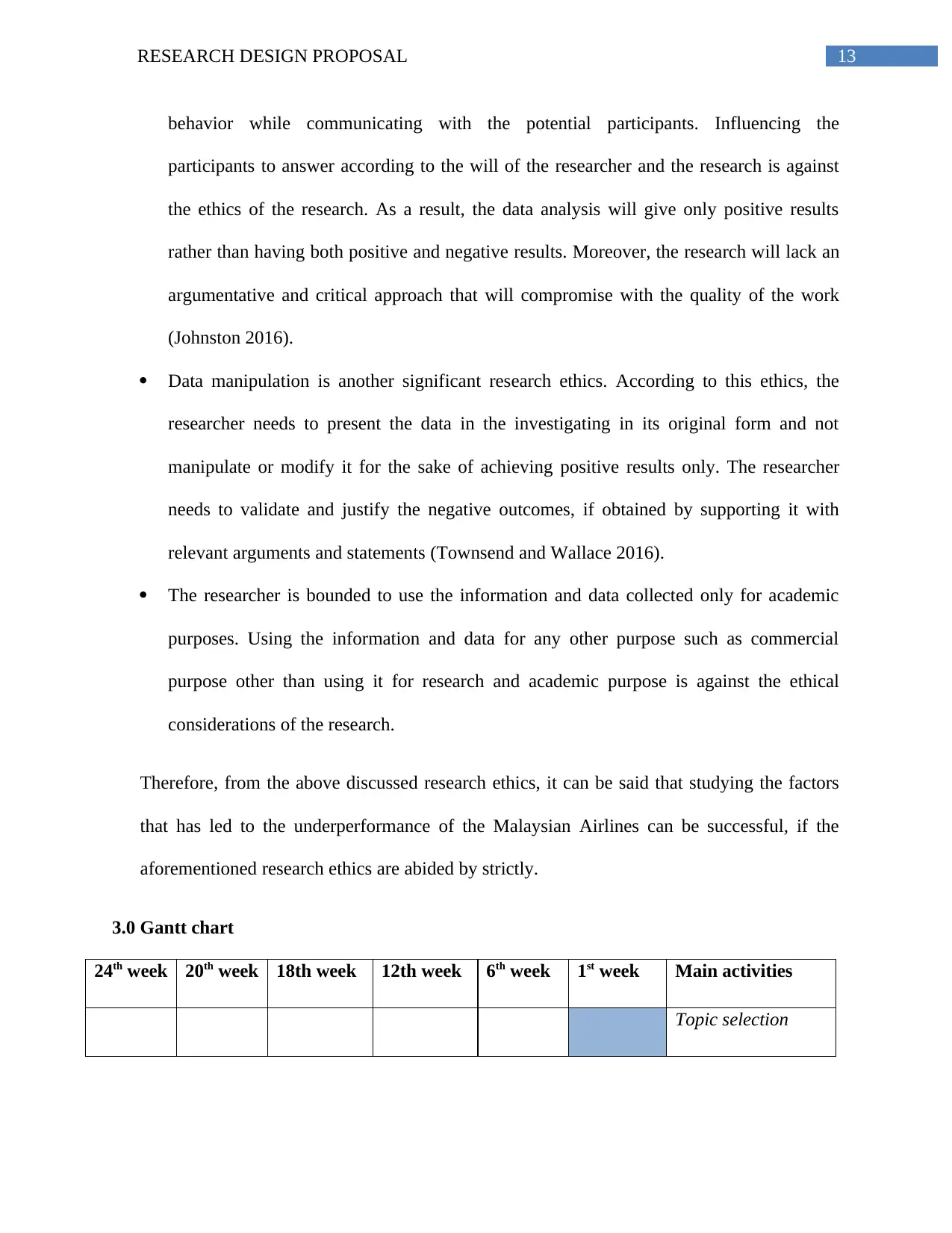
13RESEARCH DESIGN PROPOSAL
behavior while communicating with the potential participants. Influencing the
participants to answer according to the will of the researcher and the research is against
the ethics of the research. As a result, the data analysis will give only positive results
rather than having both positive and negative results. Moreover, the research will lack an
argumentative and critical approach that will compromise with the quality of the work
(Johnston 2016).
Data manipulation is another significant research ethics. According to this ethics, the
researcher needs to present the data in the investigating in its original form and not
manipulate or modify it for the sake of achieving positive results only. The researcher
needs to validate and justify the negative outcomes, if obtained by supporting it with
relevant arguments and statements (Townsend and Wallace 2016).
The researcher is bounded to use the information and data collected only for academic
purposes. Using the information and data for any other purpose such as commercial
purpose other than using it for research and academic purpose is against the ethical
considerations of the research.
Therefore, from the above discussed research ethics, it can be said that studying the factors
that has led to the underperformance of the Malaysian Airlines can be successful, if the
aforementioned research ethics are abided by strictly.
3.0 Gantt chart
Main activities1st week6th week12th week18th week20th week24th week
Topic selection
behavior while communicating with the potential participants. Influencing the
participants to answer according to the will of the researcher and the research is against
the ethics of the research. As a result, the data analysis will give only positive results
rather than having both positive and negative results. Moreover, the research will lack an
argumentative and critical approach that will compromise with the quality of the work
(Johnston 2016).
Data manipulation is another significant research ethics. According to this ethics, the
researcher needs to present the data in the investigating in its original form and not
manipulate or modify it for the sake of achieving positive results only. The researcher
needs to validate and justify the negative outcomes, if obtained by supporting it with
relevant arguments and statements (Townsend and Wallace 2016).
The researcher is bounded to use the information and data collected only for academic
purposes. Using the information and data for any other purpose such as commercial
purpose other than using it for research and academic purpose is against the ethical
considerations of the research.
Therefore, from the above discussed research ethics, it can be said that studying the factors
that has led to the underperformance of the Malaysian Airlines can be successful, if the
aforementioned research ethics are abided by strictly.
3.0 Gantt chart
Main activities1st week6th week12th week18th week20th week24th week
Topic selection
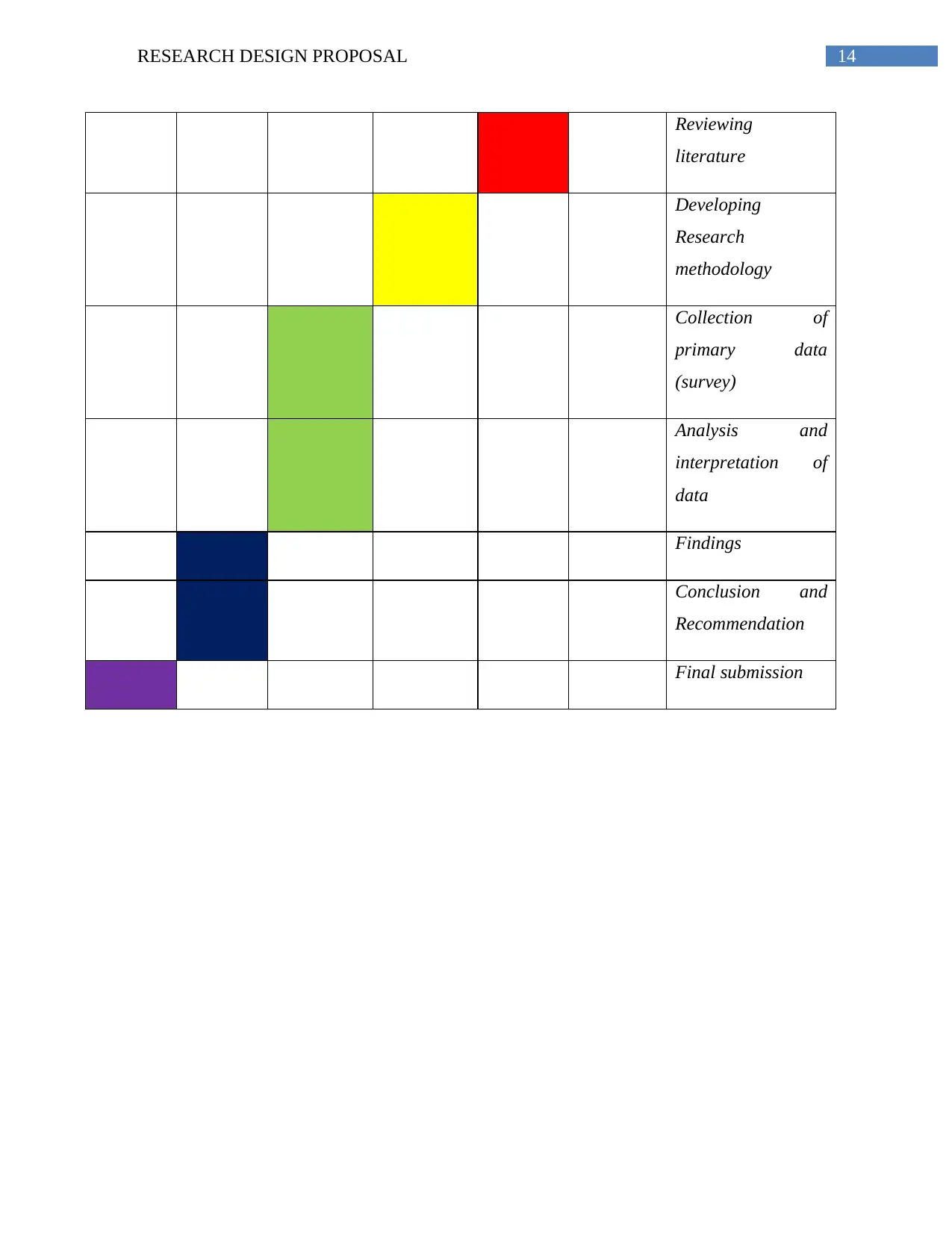
14RESEARCH DESIGN PROPOSAL
Reviewing
literature
Developing
Research
methodology
Collection of
primary data
(survey)
Analysis and
interpretation of
data
Findings
Conclusion and
Recommendation
Final submission
Reviewing
literature
Developing
Research
methodology
Collection of
primary data
(survey)
Analysis and
interpretation of
data
Findings
Conclusion and
Recommendation
Final submission
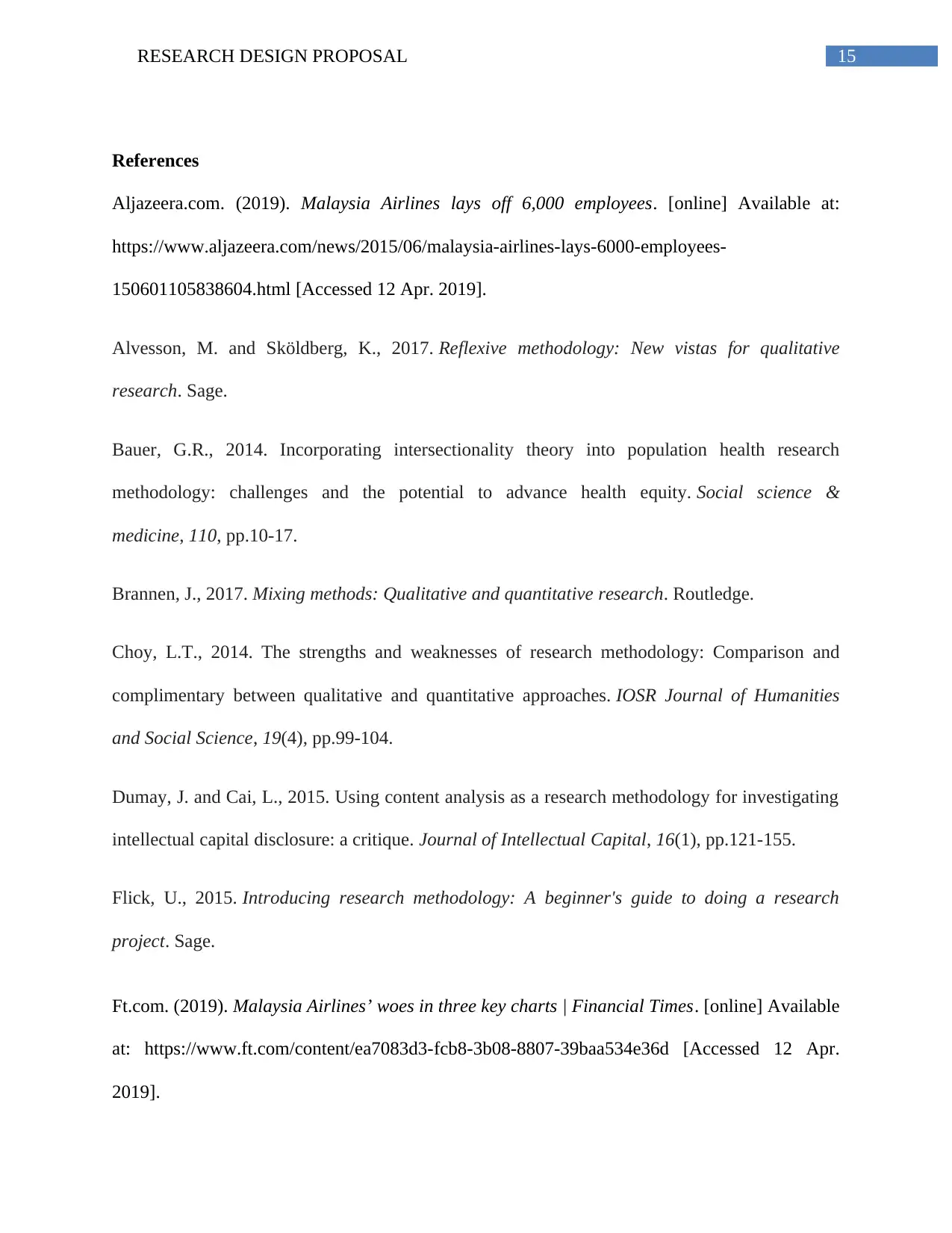
15RESEARCH DESIGN PROPOSAL
References
Aljazeera.com. (2019). Malaysia Airlines lays off 6,000 employees. [online] Available at:
https://www.aljazeera.com/news/2015/06/malaysia-airlines-lays-6000-employees-
150601105838604.html [Accessed 12 Apr. 2019].
Alvesson, M. and Sköldberg, K., 2017. Reflexive methodology: New vistas for qualitative
research. Sage.
Bauer, G.R., 2014. Incorporating intersectionality theory into population health research
methodology: challenges and the potential to advance health equity. Social science &
medicine, 110, pp.10-17.
Brannen, J., 2017. Mixing methods: Qualitative and quantitative research. Routledge.
Choy, L.T., 2014. The strengths and weaknesses of research methodology: Comparison and
complimentary between qualitative and quantitative approaches. IOSR Journal of Humanities
and Social Science, 19(4), pp.99-104.
Dumay, J. and Cai, L., 2015. Using content analysis as a research methodology for investigating
intellectual capital disclosure: a critique. Journal of Intellectual Capital, 16(1), pp.121-155.
Flick, U., 2015. Introducing research methodology: A beginner's guide to doing a research
project. Sage.
Ft.com. (2019). Malaysia Airlines’ woes in three key charts | Financial Times. [online] Available
at: https://www.ft.com/content/ea7083d3-fcb8-3b08-8807-39baa534e36d [Accessed 12 Apr.
2019].
References
Aljazeera.com. (2019). Malaysia Airlines lays off 6,000 employees. [online] Available at:
https://www.aljazeera.com/news/2015/06/malaysia-airlines-lays-6000-employees-
150601105838604.html [Accessed 12 Apr. 2019].
Alvesson, M. and Sköldberg, K., 2017. Reflexive methodology: New vistas for qualitative
research. Sage.
Bauer, G.R., 2014. Incorporating intersectionality theory into population health research
methodology: challenges and the potential to advance health equity. Social science &
medicine, 110, pp.10-17.
Brannen, J., 2017. Mixing methods: Qualitative and quantitative research. Routledge.
Choy, L.T., 2014. The strengths and weaknesses of research methodology: Comparison and
complimentary between qualitative and quantitative approaches. IOSR Journal of Humanities
and Social Science, 19(4), pp.99-104.
Dumay, J. and Cai, L., 2015. Using content analysis as a research methodology for investigating
intellectual capital disclosure: a critique. Journal of Intellectual Capital, 16(1), pp.121-155.
Flick, U., 2015. Introducing research methodology: A beginner's guide to doing a research
project. Sage.
Ft.com. (2019). Malaysia Airlines’ woes in three key charts | Financial Times. [online] Available
at: https://www.ft.com/content/ea7083d3-fcb8-3b08-8807-39baa534e36d [Accessed 12 Apr.
2019].
Secure Best Marks with AI Grader
Need help grading? Try our AI Grader for instant feedback on your assignments.
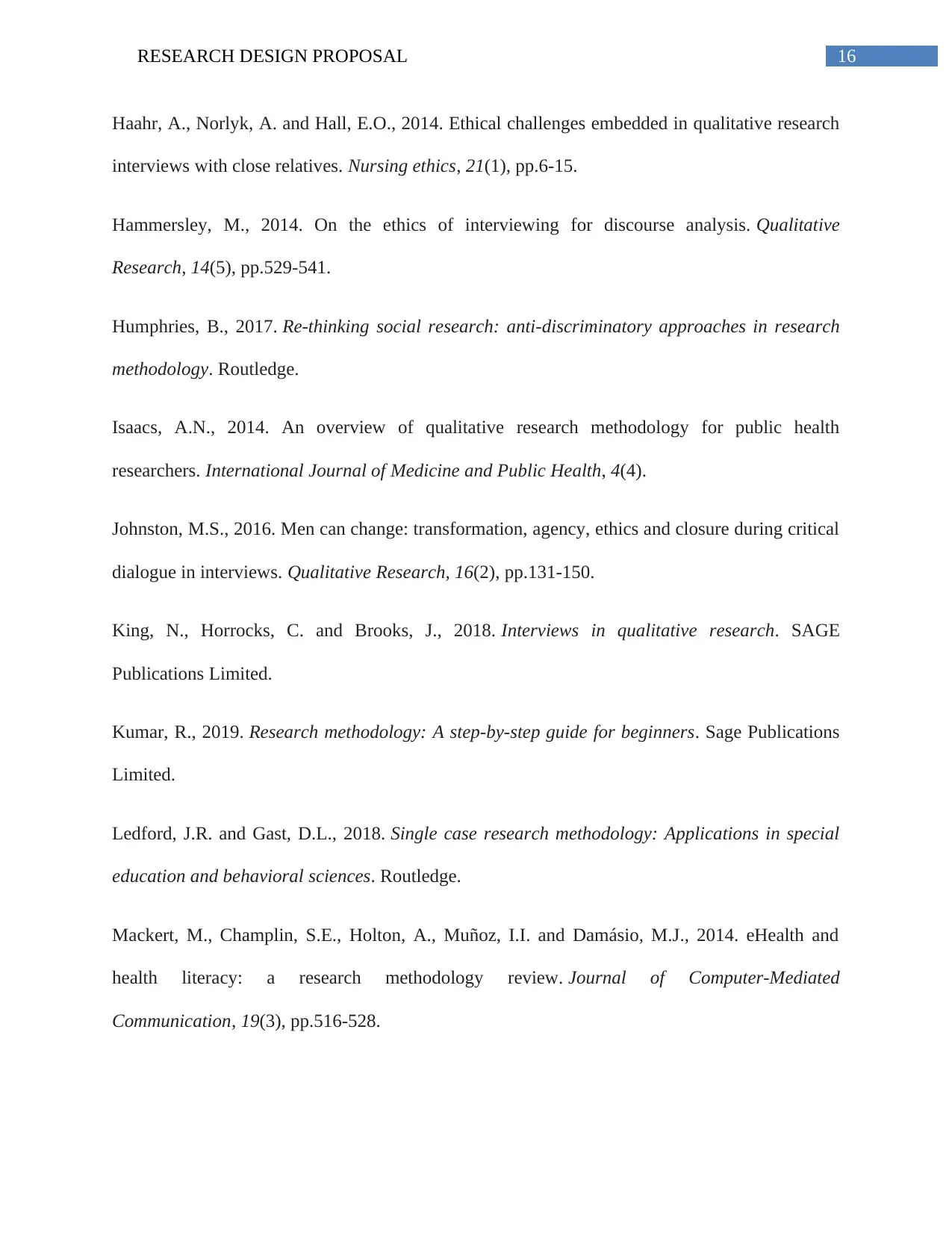
16RESEARCH DESIGN PROPOSAL
Haahr, A., Norlyk, A. and Hall, E.O., 2014. Ethical challenges embedded in qualitative research
interviews with close relatives. Nursing ethics, 21(1), pp.6-15.
Hammersley, M., 2014. On the ethics of interviewing for discourse analysis. Qualitative
Research, 14(5), pp.529-541.
Humphries, B., 2017. Re-thinking social research: anti-discriminatory approaches in research
methodology. Routledge.
Isaacs, A.N., 2014. An overview of qualitative research methodology for public health
researchers. International Journal of Medicine and Public Health, 4(4).
Johnston, M.S., 2016. Men can change: transformation, agency, ethics and closure during critical
dialogue in interviews. Qualitative Research, 16(2), pp.131-150.
King, N., Horrocks, C. and Brooks, J., 2018. Interviews in qualitative research. SAGE
Publications Limited.
Kumar, R., 2019. Research methodology: A step-by-step guide for beginners. Sage Publications
Limited.
Ledford, J.R. and Gast, D.L., 2018. Single case research methodology: Applications in special
education and behavioral sciences. Routledge.
Mackert, M., Champlin, S.E., Holton, A., Muñoz, I.I. and Damásio, M.J., 2014. eHealth and
health literacy: a research methodology review. Journal of Computer-Mediated
Communication, 19(3), pp.516-528.
Haahr, A., Norlyk, A. and Hall, E.O., 2014. Ethical challenges embedded in qualitative research
interviews with close relatives. Nursing ethics, 21(1), pp.6-15.
Hammersley, M., 2014. On the ethics of interviewing for discourse analysis. Qualitative
Research, 14(5), pp.529-541.
Humphries, B., 2017. Re-thinking social research: anti-discriminatory approaches in research
methodology. Routledge.
Isaacs, A.N., 2014. An overview of qualitative research methodology for public health
researchers. International Journal of Medicine and Public Health, 4(4).
Johnston, M.S., 2016. Men can change: transformation, agency, ethics and closure during critical
dialogue in interviews. Qualitative Research, 16(2), pp.131-150.
King, N., Horrocks, C. and Brooks, J., 2018. Interviews in qualitative research. SAGE
Publications Limited.
Kumar, R., 2019. Research methodology: A step-by-step guide for beginners. Sage Publications
Limited.
Ledford, J.R. and Gast, D.L., 2018. Single case research methodology: Applications in special
education and behavioral sciences. Routledge.
Mackert, M., Champlin, S.E., Holton, A., Muñoz, I.I. and Damásio, M.J., 2014. eHealth and
health literacy: a research methodology review. Journal of Computer-Mediated
Communication, 19(3), pp.516-528.
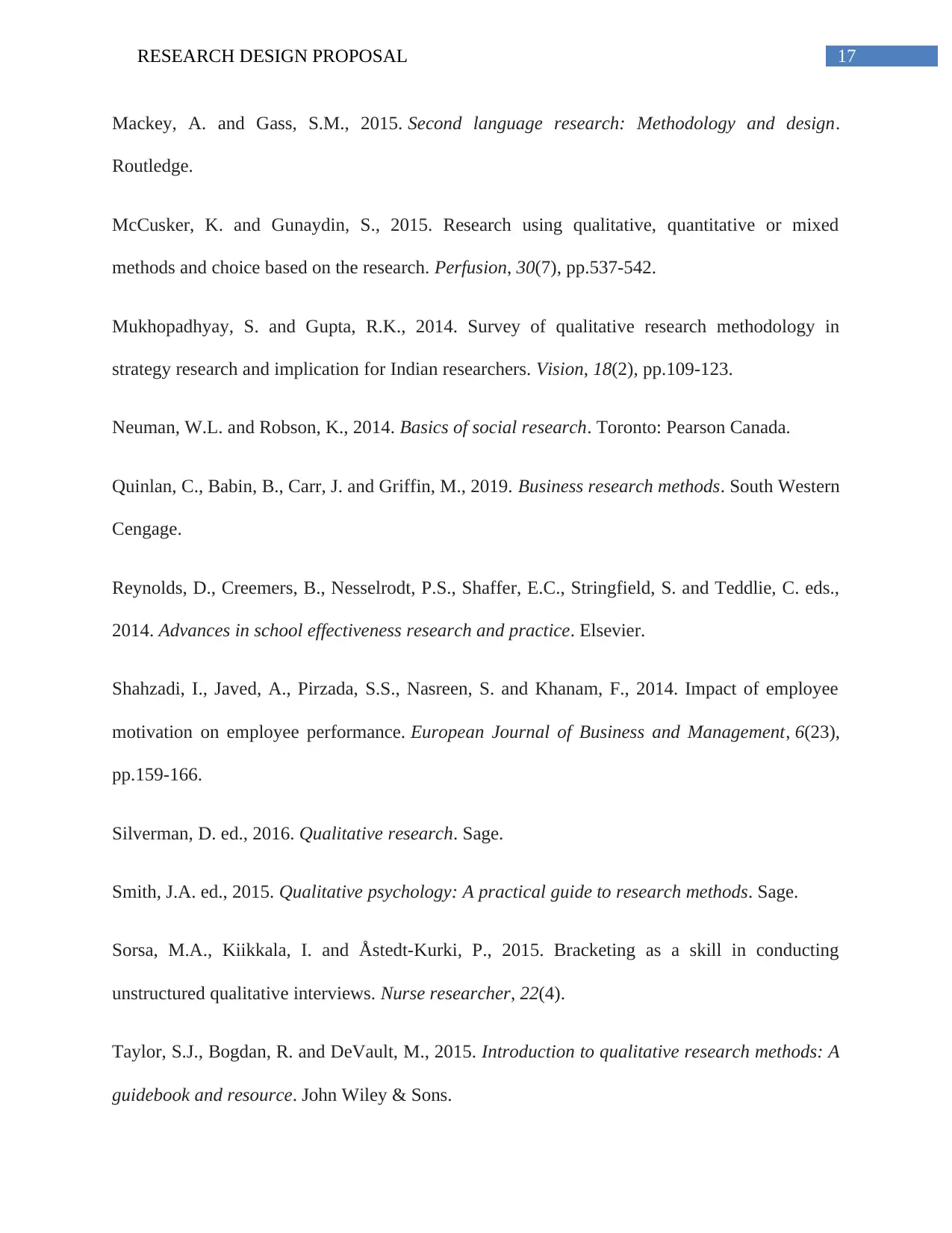
17RESEARCH DESIGN PROPOSAL
Mackey, A. and Gass, S.M., 2015. Second language research: Methodology and design.
Routledge.
McCusker, K. and Gunaydin, S., 2015. Research using qualitative, quantitative or mixed
methods and choice based on the research. Perfusion, 30(7), pp.537-542.
Mukhopadhyay, S. and Gupta, R.K., 2014. Survey of qualitative research methodology in
strategy research and implication for Indian researchers. Vision, 18(2), pp.109-123.
Neuman, W.L. and Robson, K., 2014. Basics of social research. Toronto: Pearson Canada.
Quinlan, C., Babin, B., Carr, J. and Griffin, M., 2019. Business research methods. South Western
Cengage.
Reynolds, D., Creemers, B., Nesselrodt, P.S., Shaffer, E.C., Stringfield, S. and Teddlie, C. eds.,
2014. Advances in school effectiveness research and practice. Elsevier.
Shahzadi, I., Javed, A., Pirzada, S.S., Nasreen, S. and Khanam, F., 2014. Impact of employee
motivation on employee performance. European Journal of Business and Management, 6(23),
pp.159-166.
Silverman, D. ed., 2016. Qualitative research. Sage.
Smith, J.A. ed., 2015. Qualitative psychology: A practical guide to research methods. Sage.
Sorsa, M.A., Kiikkala, I. and Åstedt-Kurki, P., 2015. Bracketing as a skill in conducting
unstructured qualitative interviews. Nurse researcher, 22(4).
Taylor, S.J., Bogdan, R. and DeVault, M., 2015. Introduction to qualitative research methods: A
guidebook and resource. John Wiley & Sons.
Mackey, A. and Gass, S.M., 2015. Second language research: Methodology and design.
Routledge.
McCusker, K. and Gunaydin, S., 2015. Research using qualitative, quantitative or mixed
methods and choice based on the research. Perfusion, 30(7), pp.537-542.
Mukhopadhyay, S. and Gupta, R.K., 2014. Survey of qualitative research methodology in
strategy research and implication for Indian researchers. Vision, 18(2), pp.109-123.
Neuman, W.L. and Robson, K., 2014. Basics of social research. Toronto: Pearson Canada.
Quinlan, C., Babin, B., Carr, J. and Griffin, M., 2019. Business research methods. South Western
Cengage.
Reynolds, D., Creemers, B., Nesselrodt, P.S., Shaffer, E.C., Stringfield, S. and Teddlie, C. eds.,
2014. Advances in school effectiveness research and practice. Elsevier.
Shahzadi, I., Javed, A., Pirzada, S.S., Nasreen, S. and Khanam, F., 2014. Impact of employee
motivation on employee performance. European Journal of Business and Management, 6(23),
pp.159-166.
Silverman, D. ed., 2016. Qualitative research. Sage.
Smith, J.A. ed., 2015. Qualitative psychology: A practical guide to research methods. Sage.
Sorsa, M.A., Kiikkala, I. and Åstedt-Kurki, P., 2015. Bracketing as a skill in conducting
unstructured qualitative interviews. Nurse researcher, 22(4).
Taylor, S.J., Bogdan, R. and DeVault, M., 2015. Introduction to qualitative research methods: A
guidebook and resource. John Wiley & Sons.
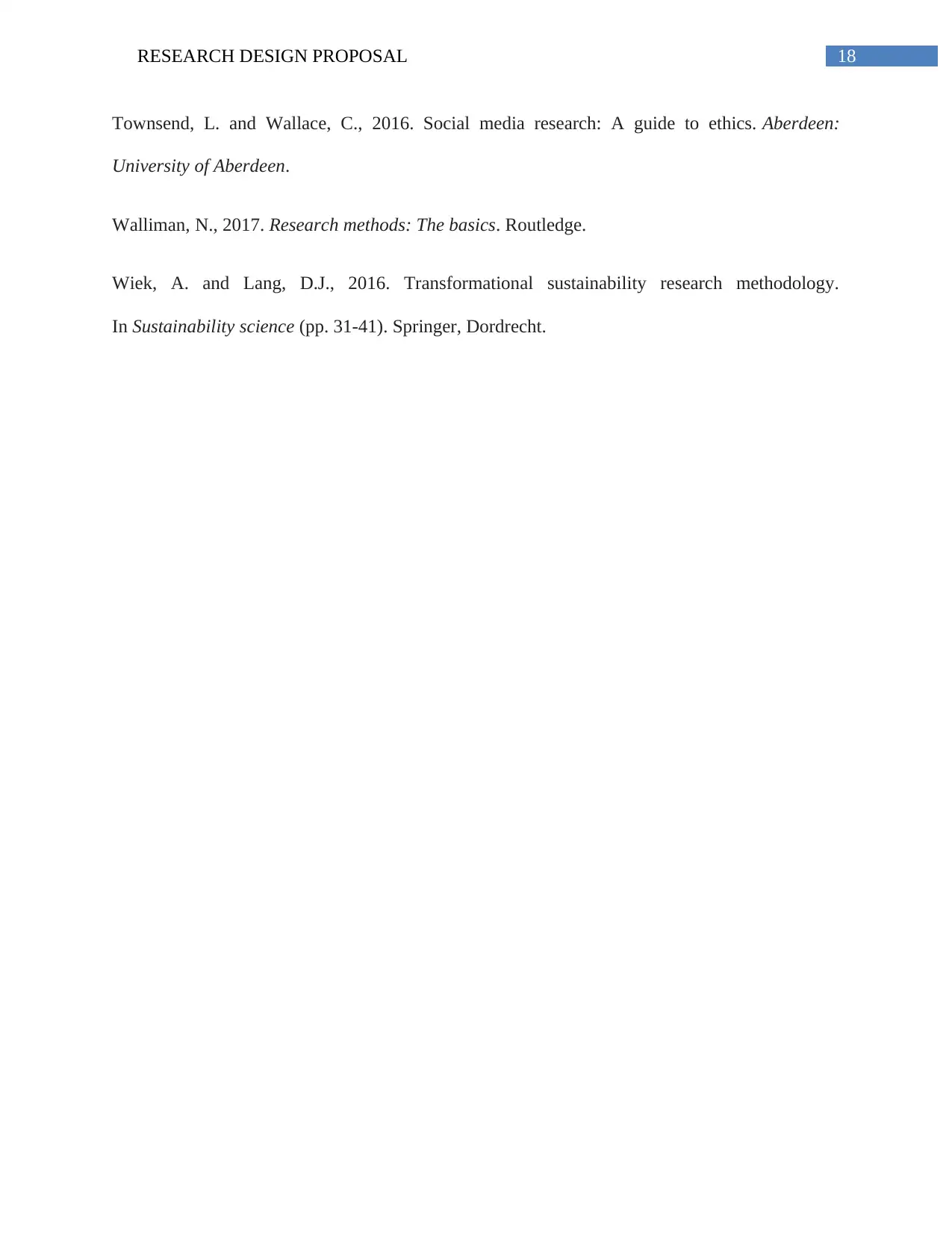
18RESEARCH DESIGN PROPOSAL
Townsend, L. and Wallace, C., 2016. Social media research: A guide to ethics. Aberdeen:
University of Aberdeen.
Walliman, N., 2017. Research methods: The basics. Routledge.
Wiek, A. and Lang, D.J., 2016. Transformational sustainability research methodology.
In Sustainability science (pp. 31-41). Springer, Dordrecht.
Townsend, L. and Wallace, C., 2016. Social media research: A guide to ethics. Aberdeen:
University of Aberdeen.
Walliman, N., 2017. Research methods: The basics. Routledge.
Wiek, A. and Lang, D.J., 2016. Transformational sustainability research methodology.
In Sustainability science (pp. 31-41). Springer, Dordrecht.
Paraphrase This Document
Need a fresh take? Get an instant paraphrase of this document with our AI Paraphraser
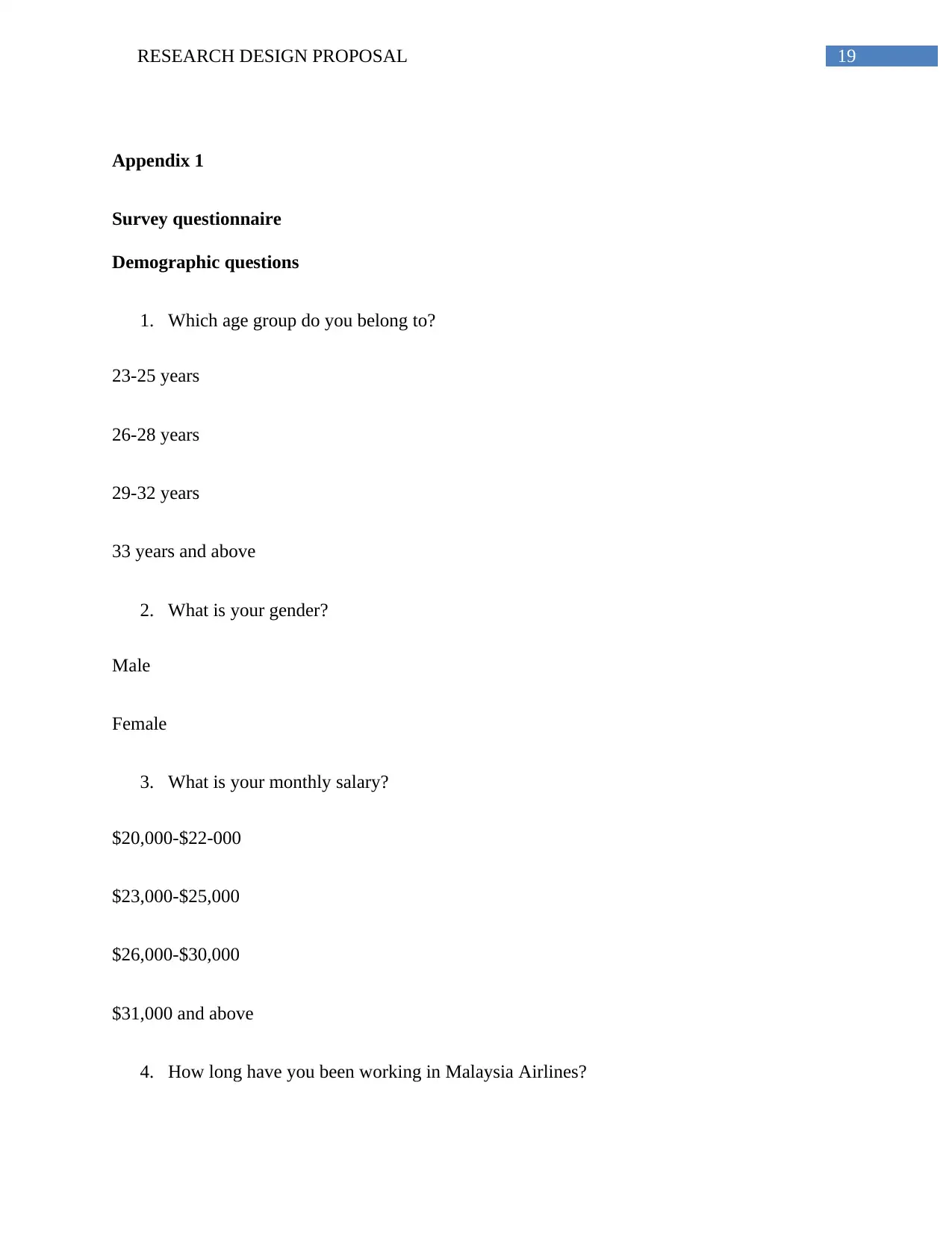
19RESEARCH DESIGN PROPOSAL
Appendix 1
Survey questionnaire
Demographic questions
1. Which age group do you belong to?
23-25 years
26-28 years
29-32 years
33 years and above
2. What is your gender?
Male
Female
3. What is your monthly salary?
$20,000-$22-000
$23,000-$25,000
$26,000-$30,000
$31,000 and above
4. How long have you been working in Malaysia Airlines?
Appendix 1
Survey questionnaire
Demographic questions
1. Which age group do you belong to?
23-25 years
26-28 years
29-32 years
33 years and above
2. What is your gender?
Male
Female
3. What is your monthly salary?
$20,000-$22-000
$23,000-$25,000
$26,000-$30,000
$31,000 and above
4. How long have you been working in Malaysia Airlines?
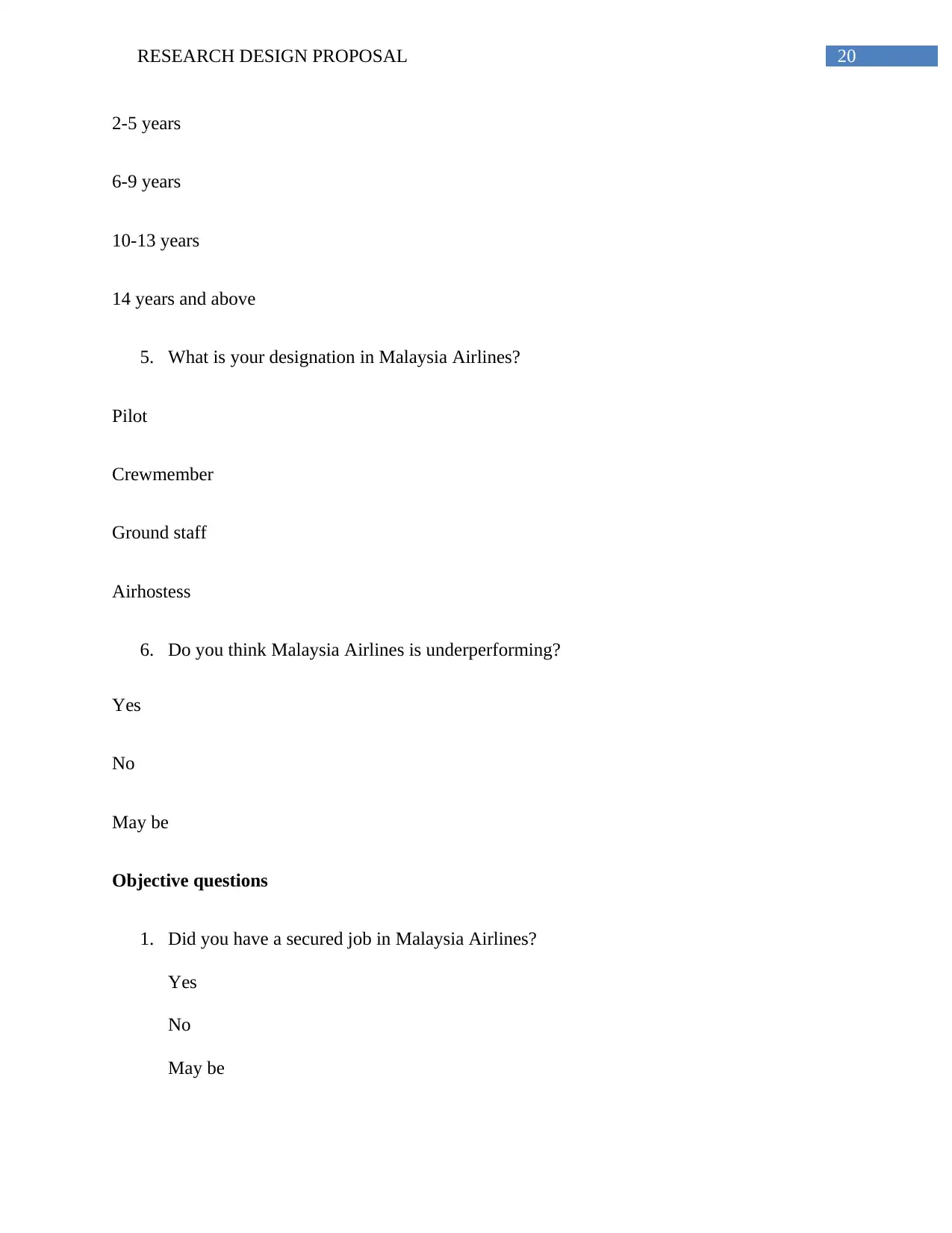
20RESEARCH DESIGN PROPOSAL
2-5 years
6-9 years
10-13 years
14 years and above
5. What is your designation in Malaysia Airlines?
Pilot
Crewmember
Ground staff
Airhostess
6. Do you think Malaysia Airlines is underperforming?
Yes
No
May be
Objective questions
1. Did you have a secured job in Malaysia Airlines?
Yes
No
May be
2-5 years
6-9 years
10-13 years
14 years and above
5. What is your designation in Malaysia Airlines?
Pilot
Crewmember
Ground staff
Airhostess
6. Do you think Malaysia Airlines is underperforming?
Yes
No
May be
Objective questions
1. Did you have a secured job in Malaysia Airlines?
Yes
No
May be
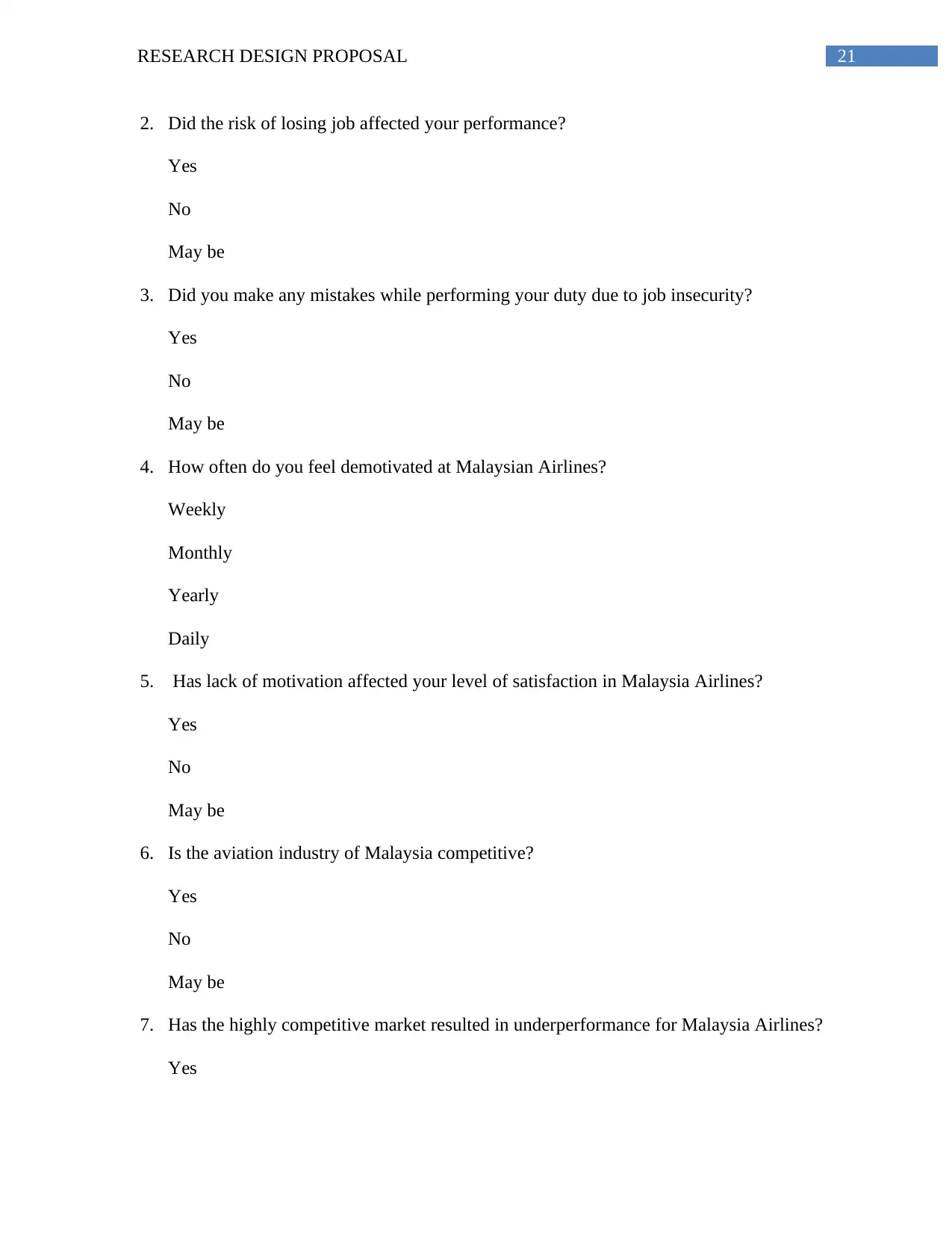
21RESEARCH DESIGN PROPOSAL
2. Did the risk of losing job affected your performance?
Yes
No
May be
3. Did you make any mistakes while performing your duty due to job insecurity?
Yes
No
May be
4. How often do you feel demotivated at Malaysian Airlines?
Weekly
Monthly
Yearly
Daily
5. Has lack of motivation affected your level of satisfaction in Malaysia Airlines?
Yes
No
May be
6. Is the aviation industry of Malaysia competitive?
Yes
No
May be
7. Has the highly competitive market resulted in underperformance for Malaysia Airlines?
Yes
2. Did the risk of losing job affected your performance?
Yes
No
May be
3. Did you make any mistakes while performing your duty due to job insecurity?
Yes
No
May be
4. How often do you feel demotivated at Malaysian Airlines?
Weekly
Monthly
Yearly
Daily
5. Has lack of motivation affected your level of satisfaction in Malaysia Airlines?
Yes
No
May be
6. Is the aviation industry of Malaysia competitive?
Yes
No
May be
7. Has the highly competitive market resulted in underperformance for Malaysia Airlines?
Yes
Secure Best Marks with AI Grader
Need help grading? Try our AI Grader for instant feedback on your assignments.

22RESEARCH DESIGN PROPOSAL
No
May be
8. Do you think Malaysia Airlines need to improve their performance?
Yes
No
May be
No
May be
8. Do you think Malaysia Airlines need to improve their performance?
Yes
No
May be
1 out of 23
Related Documents
Your All-in-One AI-Powered Toolkit for Academic Success.
+13062052269
info@desklib.com
Available 24*7 on WhatsApp / Email
![[object Object]](/_next/static/media/star-bottom.7253800d.svg)
Unlock your academic potential
© 2024 | Zucol Services PVT LTD | All rights reserved.





